Kyocera KWC-KX18 Dual-Mode Dual-Band AMPS/CDMA Cellular Phone User Manual 82 N8537 1EN
Kyocera Communications, Inc Dual-Mode Dual-Band AMPS/CDMA Cellular Phone 82 N8537 1EN
Kyocera >
User Manual
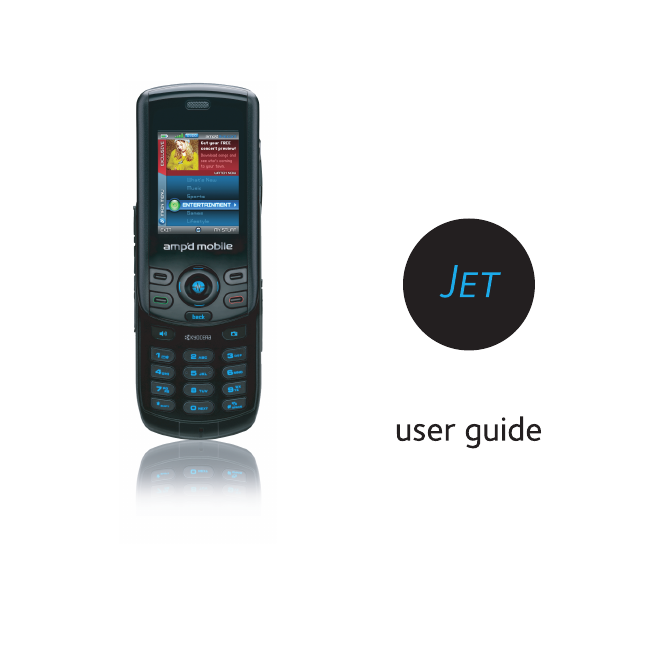
Draft

PAGE ii
User Guide for the Kyocera Jet/Angel KX18 Phone
This manual is based on the production version of
the Kyocera KX18 phone. Software changes may
have occurred after this printing. Kyocera reserves
the right to make changes in technical and product
specifications without prior notice. The products
and equipment described in this documentation
are manufactured under license from QUALCOMM
Incorporated under one or more of the following
U.S. patents:
4,901,307 5,109,390 5,267,262 5,416,797 5,506,865
5,544,196 5,657,420 5,101,501 5,267,261 5,414,796
5,504,773 5,535,239 5,600,754 5,778,338 5,228,054
5,337,338 5,710,784 5,056,109 5,568,483 5,659,569
5,490,165 5,511,073
The Kyocera Wireless Corp. (“KWC”) products
described in this manual may include copyrighted
KWC and third party software stored in
semiconductor memories or other media. Laws in the
United States and other countries preserve for KWC
and third party software providers certain exclusive
rights for copyrighted software, such as the exclusive
rights to distribute or reproduce the copyrighted
software. Accordingly, any copyrighted software
contained in the KWC products may not be modified,
reverse engineered, distributed or reproduced in any
manner not permitted by law. Furthermore, the
purchase of the KWC products shall not be deemed
to grant either directly or by implication, estoppel, or
otherwise, any license under the copyrights, patents
or patent applications of KWC or any third party
software provider, except for the normal, non-
exclusive royalty-free license to use that arises by
operation of law in the sale of a product.
Kyocera is a registered trademark of Kyocera
Corporation. Race 21 and Brick Attack are
trademarks of Kyocera Wireless Corp.
QUALCOMM is a registered trademark of
QUALCOMM Incorporated. Openwave is a
trademark of Openwave Systems Incorporated.
eZiText is a registered trademark of Zi Corporation.
TransFlash is a trademark of SanDisk Corporation.
All other trademarks are the property of their
respective owners.
Copyright © 2005 Kyocera Wireless Corp.
All rights reserved.
Ringer Tones Copyright © 2000-2002 Kyocera
Wireless Corp.
82-N8656-1EN, Rev. x1
FCC/IC Notice
This device complies with part 15 of the FCC rules.
Operation is subject to the following two conditions:
(1) This device may not cause harmful
interference, and (2) this device must accept any
interference received, including interference that
may cause undesired operation. To maintain
compliance with FCC RF exposure guidelines, if
you wear a handset on your body, use the Kyocera
Wireless Corp. (KWC) supplied and approved case
CV90-G2573-01 and holster CV90-G2958-01.
Other accessories used with this device for body-
worn operations must not contain any metallic
components and must provide at least 25 mm
separation distance including the antenna and the
user’s body.
THIS MODEL PHONE MEETS THE GOVERNMENT’S
REQUIREMENTS FOR EXPOSURE TO RADIO WAVES.
Your wireless phone is a radio transmitter and
receiver. It is designed and manufactured not to
exceed the emission limits for exposure to radio
frequency (RF) energy set by the Federal
Communications Commission of the U.S.
Government. These limits are part of
comprehensive guidelines and establish permitted
levels of RF energy for the general population. The
guidelines are based on standards that were
developed by independent scientific organizations
through periodic and thorough evaluation of
scientific studies. The standards include a
substantial safety margin designed to assure the
safety of all persons, regardless of age and health.

PAGE iii
The exposure standard for wireless mobile phones
employs a unit of measurement known as the
Specific Absorption Rate, or SAR. The SAR limit
set by the FCC is 1.6 W/kg.* Tests for SAR are
conducted using standard operating positions
specified by the FCC with the phone transmitting at
its highest certified power level in all tested
frequency bands.
Although the SAR is determined at the highest
certified power level, the actual SAR level of the
phone while operating can be well below the
maximum value.
This is because the phone is designed to operate
at multiple power levels so as to use only the
power required to reach the network. In general, the
closer you are to a wireless base station antenna,
the lower the power output.
Before a phone model is available for sale to the
public, it must be tested and certified to the FCC
that it does not exceed the limit established by the
government-adopted requirement for safe
exposure. The tests are performed in positions and
locations (e.g., at the ear and worn on the body) as
required by the FCC for each model.
Body-worn measurements differ among phone
models, depending upon availability of accessories
and FCC requirements. While there may be
differences between the SAR levels of various
phones and at various positions, they all meet the
government requirement for safe exposure.
The FCC has granted an Equipment Authorization
for this model phone with all reported SAR levels
evaluated as in compliance with the FCC RF
emission guidelines. SAR information on this
model phone is on file with the FCC and can be
found under the Display Grant section
http://www.fcc.gov/oet/fccid after searching
on the FCC ID: OVFKWC-KX18.
Additional information on SAR can be found on the
Cellular Telecommunications and Internet
Association (CTIA) web-site at
http://www.wow-com.com.
* In the United States and Canada, the SAR limit
for mobile phones used by the public is 1.6 watts/
kg (W/kg) averaged over one gram of tissue. The
standard incorporates a substantial margin of
safety to give additional protection for the public
and to account for any variations in measurements.
Caution
The user is cautioned that changes or
modifications not expressly approved by the party
responsible for compliance could void the warranty
and user’s authority to operate the equipment.
Optimize your phone’s performance
Use the guidelines on page 2 to learn how to
optimize the performance and life of your phone
and battery.
Air bags
If your vehicle has an air bag, DO NOT place
installed or portable phone equipment or other
objects over the air bag or in the air bag deployment
area. If equipment is not properly installed, you and
your passengers risk serious injury.
Medical devices
Pacemakers—Warning to pacemaker wearers:
Wireless phones, when in the ‘on’ position, have
been shown to interfere with pacemakers. The
phone should be kept at least six (6) inches away
from the pacemaker to reduce risk.
The Health Industry Manufacturers Association
and the wireless technology research community
recommend that you follow these guidelines to
minimize the potential for interference.
• Always keep the phone at least six inches
(15 centimeters) away from your pacemaker when
the phone is turned on.
• Do not carry your phone near your heart.

PAGE iv
• Use the ear opposite the pacemaker.
• If you have any reason to suspect that interference
is taking place, turn off your phone immediately.
Hearing aids—Some digital wireless phones may
interfere with hearing aids. In the event of such
interference, you may want to consult your service
provider or call the customer service line to discuss
alternatives.
Other medical devices—If you use any other
personal medical device, consult the manufacturer
of the device to determine if it is adequately
shielded from external RF energy. Your physician
may be able to help you obtain this information.
In health care facilities—Turn your phone off in
health care facilities when instructed. Hospitals
and health care facilities may be using equipment
that is sensitive to external RF energy.
Potentially unsafe areas
Posted facilities—Turn your phone off in any
facility when posted notices require you to do so.
Aircraft—FCC regulations prohibit using your
phone on a plane that is in the air. Turn your phone
off or switch it to Airplane Mode before boarding
aircraft.
Vehicles—RF signals may affect improperly
installed or inadequately shielded electronic
systems in motor vehicles. Check with the
manufacturer of the device to determine if it is
adequately shielded from external RF energy.
Blasting areas—Turn off your phone where
blasting is in progress. Observe restrictions, and
follow any regulations or rules.
Potentially explosive atmospheres—Turn off
your phone when you are in any area with a
potentially explosive atmosphere. Obey all signs
and instructions. Sparks in such areas could cause
an explosion or fire, resulting in bodily injury or
death.
Areas with a potentially explosive atmosphere are
often, but not always, clearly marked. They
include:
• fueling areas such as gas stations
• below deck on boats
• transfer or storage facilities for fuel or chemicals
• vehicles using liquefied petroleum gas, such as
propane or butane
• areas where the air contains chemicals or particles
such as grain, dust, or metal powders
• any other area where you would normally be
advised to turn off your vehicle engine
Use with care
Use only in normal position (to ear). Avoid
dropping, hitting, bending, or sitting on the phone.
Keep phone dry
If the phone gets wet, turn the power off
immediately and contact your dealer. Water
damage may not be covered under warranty.
Resetting the phone
If the screen seems frozen and the keypad does
not respond to keypresses, reset the phone by
completing the following steps:
1. Remove the battery door.
2. Remove and replace the battery.
If the problem persists, return the phone to the
dealer for service.
Accessories
Use only Kyocera-approved accessories with
Kyocera phones. Use of any unauthorized
accessories may be dangerous and will invalidate
the phone warranty if said accessories cause
damage or a defect to the phone.
Radio Frequency (RF) energy
Your telephone is a radio transmitter and receiver.
When it is on, it receives and sends out RF energy.
Your service provider’s network controls the power

PAGE v
of the RF signal. This power level can range from
0.006 to 0.6 watts.
In August 1996, the U.S. Federal Communications
Commission (FCC) adopted RF exposure
guidelines with safety levels for hand-held
wireless phones. These guidelines are consistent
with the safety standards previously set by both
U.S. and international standards bodies in the
following reports:
• ANSI C95.1 (American National Standards
Institute, 1992)
• NCRP Report 86 (National Council on Radiation
Protection and Measurements, 1986)
• ICNIRP (International Commission on
Non-Ionizing Radiation Protection, 1996)
Your phone complies with the standards set by
these reports and the FCC guidelines.
E911 mandates
Where service is available, this handset complies
with the Phase I and Phase II E911 Mandates
issued by the FCC.
Battery and charger specifications
093 453 037
Kyocera Wireless Corp.
10300 Campus Point Drive, San Diego, CA 92121
U.S.A.
Visit us at www.kyocera-wireless.com
Charger Input Output
CV90-60858-01 100-240 VAC / 50/60 Hz 4.5 V 1.5 A
CV90-60859-01 120 VAC / 60Hz 5.2 V 400 mA
Standard Battery:
CV90-N1020-05: 3.7 V / 900 mAh
Extended Battery:
CV90-N1070-05: 3.7 V / 1550 mAh

PAGE vi
CONTENTS
1 GETTING STARTED. . . . . . . . . . . . . . . . . 1
Installing the battery . . . . . . . . . . . 1
Getting to know your phone . . . . 4
2 MAKING AND ANSWERING CALLS. . . 11
Making a call . . . . . . . . . . . . . . . . 11
Silencing an incoming call . . . . . 12
Using the speakerphone . . . . . . . 12
Speed dialing . . . . . . . . . . . . . . . . 15
Setting up voicemail . . . . . . . . . . 15
Roaming . . . . . . . . . . . . . . . . . . . . 17
3 ENTERING LETTERS, NUMBERS, AND
SYMBOLS 18
4 STORING CONTACTS . . . . . . . . . . . . . . 21
Creating a new contact . . . . . . . 21
Adding a code or extension . . . . 21
Customizing your contacts . . . . . 21
Editing a contact . . . . . . . . . . . . . 23
Erasing a contact . . . . . . . . . . . . . 23
Sending a vCard . . . . . . . . . . . . . 23
Customizing a phone number . . 23
Finding contact information . . . . 24
5 USING THE CAMERA . . . . . . . . . . . . . . 25
Taking a picture . . . . . . . . . . . . . . 27
Camera key map . . . . . . . . . . . . . 28
Recording a video . . . . . . . . . . . . 29
6 AMP’D LIVE . . . . . . . . . . . . . . . . . . . . . . 31
What is Amp'd Live? . . . . . . . . . . . 31
Find stuff . . . . . . . . . . . . . . . . . . . . . 34
Try before you buy . . . . . . . . . . . . 35
Send items to friends . . . . . . . . . . 36
Enjoy Your Stuff . . . . . . . . . . . . . . . 37
Change PhoneStuff . . . . . . . . . . . 39
Launch subscriptions . . . . . . . . . . 40
Cancel a subscription . . . . . . . . . 40
Need Help? . . . . . . . . . . . . . . . . . . 42
7 USING MEDIA GALLERY. . . . . . . . . . . . 44
Accessing files . . . . . . . . . . . . . . . . 44
8 USING PUSH TO TALK . . . . . . . . . . . . . 47
PTT call types . . . . . . . . . . . . . . . . . 48
Making PTT calls and alerts . . . . . 48
Receiving PTT calls and alerts . . . 50
Saving, editing, and erasing PTT
contacts . . . . . . . . . . . . . . . . . . . . . 50
Saving, editing, and erasing PTT
groups . . . . . . . . . . . . . . . . . . . . . . . 52
9 CUSTOMIZING YOUR PHONE . . . . . . . 55
Silencing all sounds . . . . . . . . . . . . 55
Keyguard . . . . . . . . . . . . . . . . . . . . 56
Choosing ringers . . . . . . . . . . . . . . 56
Setting sounds for your phone . . . 56
Adjusting volume . . . . . . . . . . . . . . 57
Setting message alerts . . . . . . . . . 58
Using shortcuts . . . . . . . . . . . . . . . . 58
Personalizing the screen . . . . . . . . 59
Creating a secure environment . 61
Network settings . . . . . . . . . . . . . . 62
Setting position location . . . . . . . . 63
USB Mode . . . . . . . . . . . . . . . . . . . . 63
10 MUSIC, VIDEO, AND DATA . . . . . . . . . . 64
Removable memory card . . . . . . 64
USB Mode . . . . . . . . . . . . . . . . . . . . 65
11 SENDING AND RECEIVING TEXT
MESSAGES 67
Sending text messages . . . . . . . . . 67
Retrieving text messages . . . . . . . 70
Customizing message settings . . . 72
12 SENDING AND RECEIVING MULTIMEDIA
MESSAGES 74

PAGE vii
Sending multimedia messages . . 74
Receiving multimedia messages . 75
Viewing multimedia messages . . 76
13 USING TOOLS . . . . . . . . . . . . . . . . . . . . 78
Voice Memo . . . . . . . . . . . . . . . . . 78
Scheduler . . . . . . . . . . . . . . . . . . . . 78
Alarm Clock . . . . . . . . . . . . . . . . . . 80
Tip Calculator . . . . . . . . . . . . . . . . . 80
Calculator . . . . . . . . . . . . . . . . . . . . 81
Timer . . . . . . . . . . . . . . . . . . . . . . . . 82
Stopwatch . . . . . . . . . . . . . . . . . . . 82
14 USING VOICE RECOGNITION. . . . . . . . 83
Setting up voice dialing . . . . . . . . 83
Making a call using voice tags . . 83
Making a call using digit dialing . 84
Training voice recognition . . . . . . 86
15 GETTING HELP . . . . . . . . . . . . . . . . . . . 87
Index 88
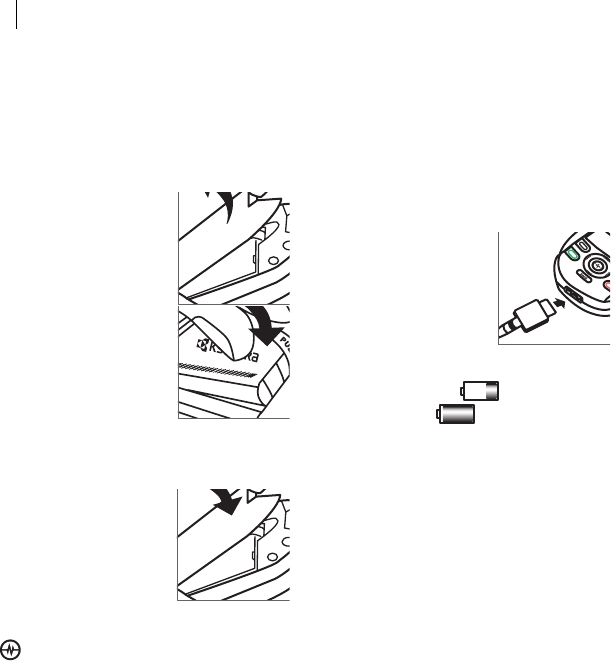
PAGE 1 Installing the battery GETTING STARTED
1 GETTING STARTED
Installing the battery
Your Kyocera Jet/Angel phone comes with
a removable lithium ion (LI Ion) battery.
Fully charge the battery before using the
phone.
To install the battery:
1. Hold the phone face
down.
2. Slide the tab at the
bottom of the door
up and remove the
battery door.
3. Place the battery in
the phone casing
with the metal
contacts facing the
right side of the
phone.
4. Replace the battery
door by sliding the notches into the
openings near
the top of the phone.
5. Snap the battery
door closed to
secure the cover into
place.
Charging the battery
You must have at least a partial charge in
the battery to make or receive calls.
To charge the battery:
1. Connect the AC adapter to the jack on
the bottom of the phone.
2. Plug the adapter into
a wall outlet.
The battery icon in the
upper-right corner of the
screen tells you whether
the phone is:
• Charging (the icon is animated)
• Partially charged
•Fully charged
Recharging the battery
You can safely recharge the battery at any
time, even if it has a partial charge.
Note: To remove the battery, make sure
the phone is powered off.

GETTING STARTED Installing the battery PAGE 2
Caring for the battery
General safety guidelines
• Do not take apart, puncture, or short-
circuit the battery.
• If you have not used the battery for
more than a month, recharge it before
using your phone.
• Avoid exposing the battery to extreme
temperatures, direct sunlight, or high
humidity.
• Never dispose of any battery in or near
a fire. It could explode.
Common causes of battery drain
• Playing games or using the Web.
• Playing music files.
• Taking pictures and videos with the
flash on.
• Keeping backlighting on.
• Operating in digital mode when far
away from a base station or cell site.
• Using data cables or accessories.
• Operating when no service is available,
or service is available intermittently.
• High earpiece and ringer volume
settings.
•Repeating sound, vibration, or lighted
alerts.
EvDO
EvDO is a standard for wireless broadband
provided by select cellphone carriers in the
United States. EvDO is an acronym for
Evolution Data Only, and enables
download speeds over cell phones
networks of up to 2.4Mb per second.
EvDO is considered the first 3G, or third
generation wireless standard to be
adopted within the US. What this means for
phones that have EvDO capability is that
not only will they be used to make and
receive phone calls and text messages, but
also will be used to quickly access
multimedia content, such as streaming or
downloaded audio or video.
Accessing keypad shortcuts
5-Way navigation key
From the home screen, press the
navigation key in one of four directions to
access three shortcuts and one custom
menu (see page 58 for instructions on
setting up your custom menu).
Your Kyocera Jet/Angel phone has a 5-
way navigation key with a round, blue
Launch Media
Player. Second press
resumes playback. of
your playlist.
Access your
custom menu
Launch
My Stuff
Launch
Messaging

PAGE 3 Installing the battery GETTING STARTED
Amp’d Live button at the center
surrounded by a 4-way circular navigation
key.
The blue Amp’d Live button has the
following functions:
•EVDO Indicator — gently pulses to
indicate that EVDO coverage (Amp’d
Live content) is available.
•OK key — acts as a standard OK
key that can be used to select
highlighted items.
•Launch Amp’d Live User Interface —
Press and hold the Amp’d/OK key
while your phone is idle to lauch the
Amp’d Live User Interface.
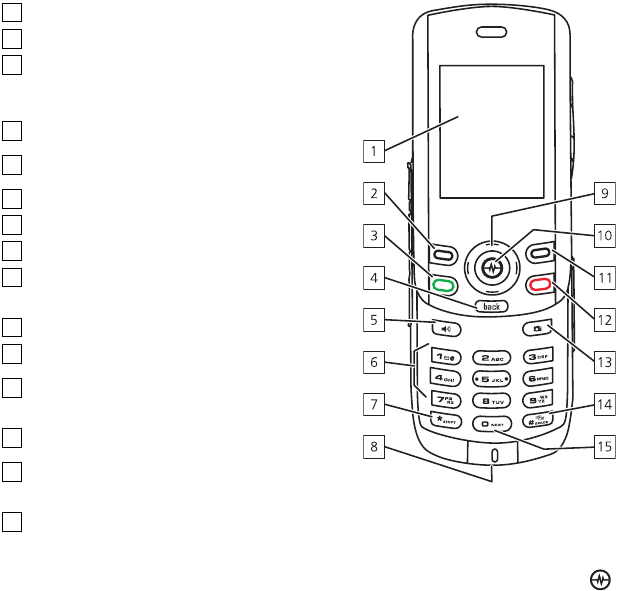
GETTING STARTED Getting to know your phone PAGE 4
Getting to know your phone
The phone is shown here in the open position. You must slide your phone open to use the
keys on the lower portion of the phone.
Home screen.
Left softkey accesses menus and functions.
Send/Talk key starts or answers a call. Press once
to activate voice dialing, twice to display the
Recent Calls list, and three times to redial the last
number dialed.
Back key erases characters in text entry and
returns you to the previous screen.
Speakerphone key activates the speakerphone
and answers incoming calls.
Keypad for entering numbers, letters, or symbols.
* Shift key changes the text mode in text entry.
Jack for AC adapter and data cable (included).
Navigation key scrolls through lists and text entry
fields and accesses shortcuts from the home
screen.
Amp’d/OK key selects a menu item or option.
Right softkey accesses the Contacts directory
and other menu options.
End/Power key turns the phone on and off, ends
a call or browser session, and returns you to the
home screen.
Internal camera key activates camera/video
mode.
Space # key enters a space during text entry.
Press and hold to activate or deactivate Silent
mode.
0 Next key cycles through word choices during text entry.
1
2
3
4
5
6
7
8
9
10
11
12
13
14
15
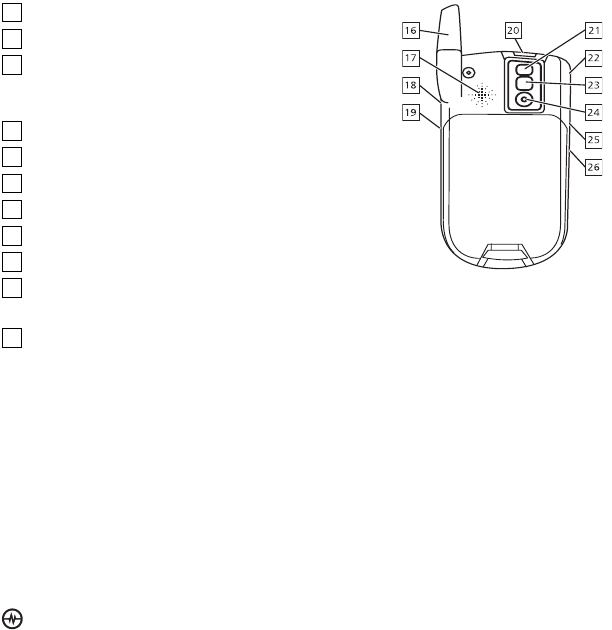
PAGE 5 Getting to know your phone GETTING STARTED
Antenna does not extend.
Speaker for ringers, speakerphone and music.
External camera key activates Camera mode. To
activate Camera mode, press and hold until you hear
one beep. Press and hold until you hear two beeps for
Video mode.
TransFlash slot for external memory card.
Message Indicator Light
Camera flash
Jack for hands-free headset (sold separately).
Mirror when taking your own picture.
Camera lens
Volume key to raise or lower speaker volume. Press
and hold up or down to activate/deactivate Silent
Mode.
PTT - Activate Push-to-Talk, or with slider closed use to
Pause/Play music.
16
17
18
19
20
21
22
23
24
25
26

GETTING STARTED Getting to know your phone PAGE 6
Using menus
Accessing menu items
From the home screen:
• Press the left softkey to select
Menu.
• Press the right softkey to select
Contacts.
• Press the Navigation key left, right,
up, or down to see menus and options.
• Press the Amp’d/OK key to select a
menu item.
• Press the back key to back up a
menu level.
• Press the End/Power key to return
to the home screen.
In this guide, an arrow → tells you to select
an option from a menu.
For example, Menu → Settings means
select Menu, then select the Settings
option.
Note: To change the way the menus
appear, see “Choosing a menu view” on
page 59 for details.
The contents of the main menu are as follows:
Recent Calls
All Calls
Incoming Calls
Outgoing Calls
Missed Calls
Erase Call Lists
Recent Calls
Timer
All Calls Timer
Home Calls
Timer
Roam CAlls
Timer
Kilobyte
Counter
Contacts
View All
Add New
Find Name
PTT Contacts
Contacts (Cont)
PTT Groups
Speed Dial List
Voice Dial List
Messaging
Groups
Business List
Personal List
Information
PTT
Amp’d Live
Media Gallery
Camera
Pictures
Images
Sounds
Videos
Messages
New Text Msg
New Pix Msg
Voicemail
InBox
Browser Alerts
Sent
OutBox
Saved
Drafts
Msg Settings
Group Lists
Erase Messages
Settings
Silent Mode
Keyguard
Sounds
Display
Convenience
Memory Card
Voice Features
Messaging
Security
Network
Accessories
USB Storage
Camera
Launches the
camera
Tools
Voice Memo
Scheduler
Alarm Clock
Stopwatch
Phone Info
Platform
Your Number
SW Version
PRL Version
Factory Config
ESN
Technology
SID
Browser Info
ERI Version
Icon Key
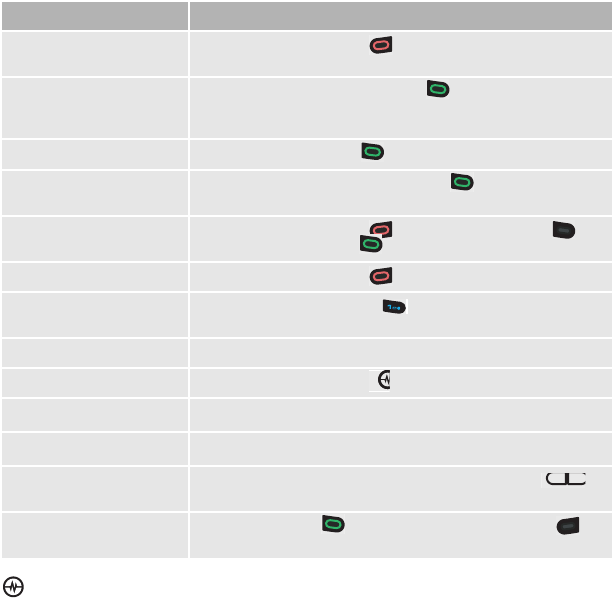
PAGE 7 Getting to know your phone GETTING STARTED
Performing basic functions
Note: The phone must be powered ON to perform the following functions.
To... From the home screen...
Turn the phone on Press the End/Power key and wait until the phone
beeps.
Make a call Press and hold the Send/Talk key to initiate voice
dialing. Contact must have voice tag assigned (see
page 83).
Answer a call Press the Send/Talk key .
Activate voice dialing Say “Dial” or press the Send/Talk key once and follow
the prompts (see page 83).
Silence the ringer on an
incoming call
Press the End/Power key or the right softkey(??)
then the Send/Talk key to answer.
End a call Press the End/Power key .
Access voicemail Press and hold the “1” key and follow the system
prompts.
Push to Talk Press [PTT key]
Launch Amp’d Live Press the Amp’d/OK key .
Verify your phone number Select Menu → Phone Info.
Record a voice memo Select Menu → Tools → Voice Memo → Record New.
Adjust volume during a
call
Press the volume key on the left side of the phone
up or down.
Acknowledge an alert Press the end kye to stop, or the right softkey(??) to
snooze.

GETTING STARTED Getting to know your phone PAGE 8
Access customized
shortcut Press the Navigation key up (see page 58).
Access My Stuff Press the Navigation key left.
Access Messaging
Menu Press and hold the Navigation key down.
Access Recent Calls list Press the End/Power key twice.
Launch Amp’d Live
Media Player Press the Navigation key right.
Resume Music
playback Press the Navigation key right twice.
Select menus Highlight a menu or option and press the Amp’d/OK key
once.
Activate Camera mode Press and hold the side camera key .
Take a picture Activate Camera mode and press the left softkey .*
Press camera key . Focus on the image and select
Capture.**
Switch from Camera to
Video mode. From Camera mode, press and hold the side camera
key .
Record a video Activate Video mode and press left softkey .*
Press the camera key . Select Options → Video Mode.
Focus on the image and select Record. To stop recording,
select Stop.**
* Funtion works when slide is closed
** Funtion works when slide is open
To... From the home screen...
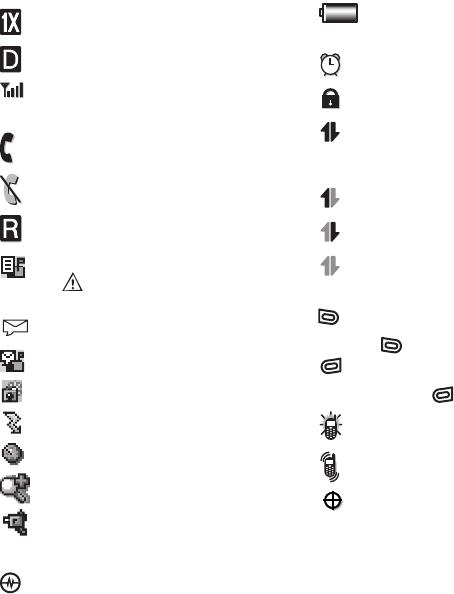
PAGE 9 Getting to know your phone GETTING STARTED
Understanding screen icons
These icons may appear on your phone’s screen.
The phone is operating in IS2000 (1X)
digital mode.
The phone is operating in IS95
digital mode.
The phone is receiving a signal. You
can make and receive calls. Fewer
bars indicate a weaker signal.
A call is in progress.
The phone is not receiving a signal.
You cannot make or receive calls.
The phone is roaming outside of its
home service area.
You have a text message.
( indicates the message is
urgent.)
You have a voice message.
You have a voice/text message.
The phone is in camera mode.
Camera flash mode is ready.
Camera timer mode is ready.
Camera zoom mode is ready.
The phone is in video mode.
The battery is fully charged. The
more black bars, the greater
the charge.
The alarm clock is set.
The phone is in privacy mode or is
accessing a secure Web site.
High-speed (3G) data service is
available and active on your
phone. Check with your service
provider for availability.
(blinking) The phone is sending high-
speed data.
(blinking) The phone is receiving
high-speed data.
High-speed data service is
available, but the phone is
dormant.
The phone is at the home screen. To
access Menu, press the left softkey
.
The phone is at the home screen. To
access Contacts, press the right
softkey .
The phone is set to light up instead
of ring.
The phone is set to vibrate or to
vibrate and then ring.
Position location is set to your
service provider and to
emergency services.

GETTING STARTED Getting to know your phone PAGE 10
Position location is set to
emergency services only.

PAGE 11 Making a call MAKING AND ANSWERING CALLS
2 MAKING AND ANSWERING CALLS
Making a call
Make sure you are in an area where a signal can be received. Look for the symbol on
the home screen. The more bars you see in this symbol, the stronger the signal. If there are
no bars, move to where the signal strength is better.
When the phone has been idle for a time, it
changes to power save mode. When you
see “Power Save” on your phone’s screen,
press any key to return to normal operating
mode.
Slide open
1. Open the slide.
2. Enter the phone number and press the
Send/Talk key .
3. Press the End/Power key or close
slide. (If “Close to End” is enabled See
“Ending calls using the slide” on this
page).
Slide closed
You can only use the voice dialing feature
when calling with the slide closed. Voice
dialing requires that a contact be saved
with a voice tag. See “Creating a voice
tag for a contact” on page 83.
1. Press and hold the Send/Talk key to
initiate voice dialing.
2. Say the name of the contact when
prompted. The phone places the call.
3. Press End/Power key once.
Ending calls using the slide
You can set the phone to end calls
immediately when you close the slide.
• Select Menu → Settings →
Convenience → Close to End →
Enabled.
– Select Disabled to have the phone
call continue when you close the
slide.
Answering a call
When a call comes in, the phone rings,
vibrates, or lights up. The phone number of
the caller also appears if it is not restricted.
If the number is stored in your Contacts
directory, the contact name appears.
Slide open
• Press the Send/Talk key to answer
the incoming call.
-or-
• Press the speaker key to answer
the incoming call and turn on the
speakerphone.

MAKING AND ANSWERING CALLS Silencing an incoming call PAGE 12
Slide closed
• Press the Send/Talk key to select
Answer Call.
Answering calls using the slide
You can set the phone to answer
immediately when you open the slide. This
feature does not apply to incoming data or
fax calls.
• Select Menu → Settings →
Convenience → Open to Answer →
Enabled.
– Select Disabled to have the phone
continue ringing when you open the
slide.
Adjusting the volume during a call
• To adjust the earpiece volume during a
call, press the folume key on the side of
the phone up or down.
Silencing an incoming call
• Press the End/Power key or the left
softkey .
Note: In the absence of voicemail, this
feature drops the call.
- or -
• Press the End/Power key then press
the Send/Talk key twice to answer
the call.
This action silences the current call only.
The next call will ring as normal.
Redialing a number
• To redial a recent call, press the Send/
Talk key twice to open your Recent
Calls list. Highlight a phone number or
name and press the Send/Talk key .
Tip: To redial the last number called,
received, or missed, press the Send/Talk
key three times.
Calling a saved number
If you have already saved a phone
number, you can use the Contacts list to
find it quickly.
1. From the home screen, press the right
softkey to select Contacts.
2. Scroll down the list to find the contact
you want to call.
3. Highlight the name and press the Send/
Talk key to dial the number.
Using the speakerphone
Your Kyocera Jet/Angel phone has a built-
in speakerphone.
• To turn on the speaker, open the slide
and press the speaker key . If you
press the speaker key during an
incoming call alert, you answer the call.

PAGE 13 Using the speakerphone MAKING AND ANSWERING CALLS
The icon at the top of the phone
screen indicates that the speakerphone
is on.
• To turn off the speakerphone, open the
slide and press the speaker key .
Setting the phone to hold
calls
The Hold Call feature allows you to place
incoming calls on hold until you are ready
to answer them.
Note: This feature will not work if “Open to
Answer” is enabled. See “Answering calls
using the slide” on page 12.
1. Select Menu → Settings →
Convenience → Hold Call→ Enabled.
– If you have not recorded a hold
message, you will be prompted to
record one, such as “Please hold. I’ll
answer in a minute.”
2. Record the message twice, as
prompted.
3. Select Save or Options (Play, Re-
Record, or Exit).
The next time a call comes in, you will have
the option of placing it on hold.
Placing a call on hold
You can place a call on hold once you
have enabled this feature.
Note: If you are already on a call and you
receive another call, you cannot place the
incoming call on hold. It will go to
voicemail.
1. When a call comes in, press the right
softkey to select Options, then
scroll down to select the Hold Call
option. The caller will be placed on hold
and will hear your recorded hold
message.
2. To speak to the caller, select Answer
Call.
- or -
To hang up without speaking to the
caller, select End Call.
Changing the hold message
1. Select Menu → Settings →
Convenience → Hold Call →
Re-Record Msg and follow the prompts.
2. Record the message twice.
3. Select Save or Options (Play, Re-
Record, or Exit).
Dealing with missed calls
When you have missed a call, “Missed Call”
appears on your screen unless the caller
leaves a voicemail.
• To clear the screen, press the left
softkey to select OK.
• To view details of the call, press the right
softkey to select Calls then press the
Amp’d/OK key .

MAKING AND ANSWERING CALLS Using the speakerphone PAGE 14
• To return the call, press the right softkey
to select Calls then press the Send/
Talk key .
Setting missed call alerts
You can set an alert to beep every five
minutes after you have missed a call.
1. Select Menu → Settings → Sounds →
Missed Call Alert.
2. Select an option and press the Amp’d/
OK key .
Viewing recent call details
Details on the last 60 calls you made,
received, or missed are stored in the
Recent Calls list and are identified by the
following icons:
Viewing recent calls
1. Select Menu → Recent Calls.
2. Select a list: All Calls, Incoming Calls,
Outgoing Calls, or Missed Calls.
3. Select a recent call item and press the
right softkey to select Options:
–Save adds the phone number to the
Contacts list.
–Send Msg sends a text message to
the contact.
–Send Picture Msg sends a picture
message to the contact.
–Erase erases the selected call
record.
Note: If the phone number has been
classified as “secret,” you must enter your
four-digit lock code to view or edit it. For
information on the lock code,
see “Changing your lock code” on
page 61.
To classify a phone number as secret, see
“Creating a new contact” on page 21.
Calling recent calls
Slide open or closed
1. Press the Send/Talk key twice.
2. Highlight the number you want to call
and press the Send/Talk key .
-or-
1. Select Menu → Recent Calls →
Outgoing Calls.
2. Highlight the number you want to call
and press the Send/Talk key .
Erasing recent calls
1. Select Menu → Recent Calls → Erase
Call Lists.
2. Select an option: All Calls, Incoming
Calls, Outgoing Calls, or Missed Calls.
3. Press the left softkey to select Yes.
Outgoing call Incoming call
Missed call (flashing)

PAGE 15 Speed dialing MAKING AND ANSWERING CALLS
Speed dialing
Before you can use speed dialing, you must
save a phone number as a contact and
assign a speed dial location to it.
• To add a speed dial location to a saved
or new contact, see “Customizing a
phone number” on page 23.
Using speed dialing
To call a contact that has a speed dial
location:
• From the home screen, enter the one-
or two-digit speed dialing location and
press .
1-Touch dialing
1-Touch dialing is the fastest way to speed
dial a contact that has a speed dial
location.
Note: You must (1) enable 1-Touch dialing
on your phone and (2) have a speed dial
location assigned to a contact.
Enabling 1-Touch dialing
• Select Menu → Settings →
Convenience → 1-Touch Dialing →
Enabled.
Using 1-Touch dialing
To call a contact that has a speed dial
location:
• From the home screen, press and hold
the speed dialing number. If it is a two-
digit number, press the first digit briefly,
then press and hold the second digit.
For example, if the speed dialing
location is 15, press the “1” key
briefly, then press and hold the “5” key
.
Setting up voicemail
Before your phone can receive voicemail
messages, you must set up a password and
record a personal greeting with your
service provider. When you have set up
your voicemail, all unanswered calls to your
phone are automatically transferred to
voicemail, even if your phone is in use or
turned off.
1. From the home screen, press and hold
the “1” key .
2. Press the “1” key at the message.
3. Follow the system prompts to create a
password and record a greeting.
Note: If you are having trouble accessing
your voicemail, contact your
service provider.
Checking voicemail messages
When a voice message is received, your
screen displays “New Messages” along
with the symbol at the top of your
screen. The symbol flashes if the message is
urgent.

MAKING AND ANSWERING CALLS Setting up voicemail PAGE 16
If you see “New Messages”
Slide open or closed
1. Press the right softkey to select Call,
which initiates a call to your voicemail
number.
2. Follow the prompts to retrieve the
message.
To clear the screen without checking
messages:
• Press the left softkey to select
Ignore.
If you see only the symbol
Slide open
1. Press and hold the “1” key to
initiate a call to your voicemail number.
2. Follow the prompts to retrieve the
message.
• You can set the phone to beep or
vibrate every five minutes to remind you
that you have voicemail. See “Setting
message alerts” on page 58.
Slide closed
1. Select Menu → Messages →
Voicemail.
2. Press the left softkey to retrieve your
voicemail.
Calling emergency services
Note: Regardless of your 3-digit
emergency code (911, 111, 999, 000, etc.),
your phone operates as described below.
• Dial your 3-digit emergency code and
press the Send/Talk key .
You can call the code even if your phone is
locked or your account is restricted. When
you call, your phone enters Emergency
mode. This enables the emergency service
exclusive access to your phone to call you
back, if necessary. To make or receive
regular calls after dialing the code, you
must exit this mode.
To exit Emergency mode
When you have completed the
emergency call:
1. Press the Amp’d/OK key to select
Exit.
2. Press the Amp’d/OK key again to
confirm your choice.
Note: To determine who has access to your
location, see “Setting position location” on
page 63.
Tracking calls
You can track the number and duration of
calls made and received on your phone.
1. Select Menu → Recent Calls.
2. Select a timer:

PAGE 17 Roaming MAKING AND ANSWERING CALLS
–Recent Calls Timer tracks all calls you
have made and received since you
last reset this timer. To reset this timer
to zero, press the right softkey to
select Reset.
–All Calls Timer tracks all calls you
have made and received. This timer
cannot be reset.
Timing your calls
You can set your phone to beep 10
seconds before each minute passes when
you are on a call.
• Select Menu → Settings → Sounds →
Minute Alert → Enabled.
Roaming
Setting an alert for roaming
You may use this setting if you want the
phone to alert you when you roam outside
of your home service area.
1. Select Menu → Settings → Network →
Roam/Svc Alert.
2. Select an option and press the Amp’d/
OK key .
–When no svc alerts you with three
tones decreasing in pitch when
service is lost and three tones
increasing in pitch when service is
acquired again.
–On roam change alerts you with two
decreasing tones when roaming
service is acquired and three
increasing tones when home area
service is acquired again.
–On any change alerts you with three
increasing tones if there is a change
in roaming service or three
decreasing tones if the phone loses
service.
Setting the roam ringer
You can set a ringer to indicate when an
incoming call will be subject to roaming
charges.
• Select Menu → Settings → Sounds →
Roam Ringer → Enabled.
Setting Call Guard
You can set the phone to warn you before
you answer or place a call while roaming.
• Select Menu → Settings →
Convenience → Call Guard →
Call prompt.
– The phone now emits a distinctive
roam ring to indicate when you are
roaming during calls.
– To accept or place a call while
roaming, you must press the “1”
key .
Note: Call Prompt is disabled when the
phone is in Emergency Mode.
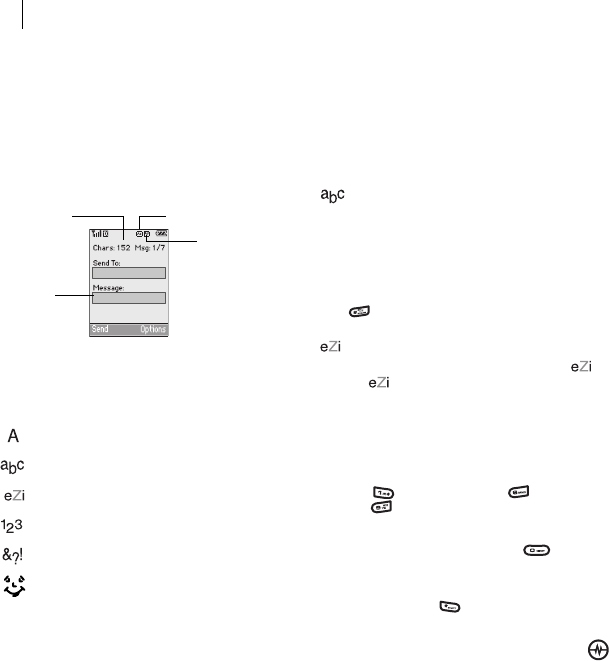
ENTERING LETTERS, NUMBERS, AND SYMBOLS PAGE 18
3 ENTERING LETTERS, NUMBERS, AND SYMBOLS
You can enter letters, numbers, and symbols in contacts, text messages, and your banner.
Understanding text entry
screens
The current text entry mode (and
capitalization setting, when applicable)
are indicated by icons.
Text entry modes
There are five text entry modes:
Case change
Normal alpha
Rapid Entry
Numbers only
Add Symbol
Add Smiley
Note: The mode you start in depends on
the task you are doing. For example, when
entering a phone number, you’re in
number mode. When entering a name for
a contact, you’re in normal text mode. See
“Changing modes” on page 19.
Entering words letter by letter
1. Press a key once for the first letter, twice
for the second letter, and so on.
2. Wait for the cursor to move right and
enter the next letter.
Note: To enter a space, press the Space #
key .
Entering words quickly
When you press a series of keys using
mode, checks its dictionary of
common words and guesses at the word
you are trying to spell.
1. For each letter of the word you want,
press the key once. For example, to
enter the word “any” press the “1”
key → the “6” key → the "9"
key .
2. If the word doesn’t match what you
want, press the 0 Next key to look
at other word matches.
3. When you see the word you want, press
the * Shift key .
text entry
field
text entry mode
capitalization setting
characters
remaining

PAGE 19 ENTERING LETTERS, NUMBERS, AND SYMBOLS
Entering numbers
• To enter a number while in mode,
press a number key once.
• To enter a number while in or
mode, press and hold a number key
until the number appears on the screen.
Entering symbols
While entering text, you can enter symbols
by pressing the “1” key until you see
the symbol you want. Using this method,
you have access to the following symbols:
To access the full set of symbols:
1. From the text entry screen, select
Options.
2. Select Add Symbol.
3. Press down to view the list of
symbols.
4. Press the number key corresponding to
the symbol you want.
Entering smileys
1. From the text entry screen, select
Options.
2. Select Add Smiley.
3. Press the Navigation key down to
view the list of smileys.
4. Press the number key corresponding to
the smiley you want.
Switching default text entry modes
You can change the default text entry
mode when creating a text message. This
setting applies only to the message body
screen, not the “To” screen.
1. Select Menu → Messages →
Msg Settings → Default Text.
2. Select Normal Alpha or Rapid Mode.
Changing modes
Sometimes you need to change modes.
For example, to enter numbers in an email
address while in mode, you must
change to mode, enter the numbers,
and then change back to mode to
complete the address.
To change text entry modes:
• Press and hold until the icon for the
mode you want appears at the top of
the screen.
-or-
• Select Options then select a different
mode.
Capitalization settings
• You can change capitalization at any
time while entering text. Simply press the
* Shift key key to choose upper or
lower case while in Normal Alpha
mode.
.@?!-,&:‘1
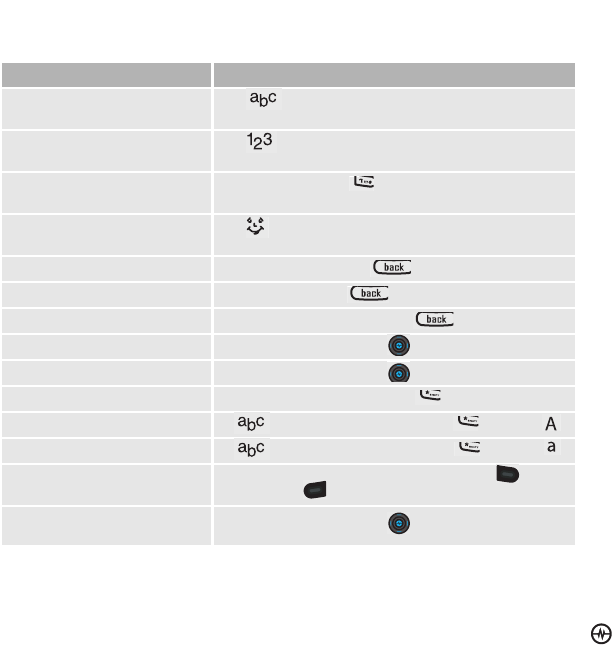
ENTERING LETTERS, NUMBERS, AND SYMBOLS PAGE 20
Quick reference to text entry
This table gives general instructions for entering letters, numbers, and symbols.
To... Do this...
Enter a letter Use mode and press a key until you see the
letter you want. For more information, see page 18.
Enter a number Use mode and press a key once to enter its
number. For more options, see page 18.
Enter a symbol Press the * Shift key until you find the symbol
you want. See page 19.
Enter a smiley Use mode and press a key once to enter its
number. For more options, see page 19.
Enter a space Press the Space # key .
Erase a character Press the back key .
Erase all characters Press and hold the back key .
Move the cursor right or left Press the Navigation key right or left.
Move the cursor up or down Press the Navigation key up or down.
Change text entry modes Press and hold the * Shift key .
Capitalize any letter In mode, press the * Shift key . Choose .
Lowercase any letter In mode, press the * Shift key . Choose .
Select soft options on the
screen
Press the appropriate key, the left softkey or the
right softkey .
Highlight an option at the
bottom of the screen Press the Navigation key right or left.

PAGE 21 Creating a new contact STORING CONTACTS
4 STORING CONTACTS
Use your phone’s Contacts directory to store information about a person or company. Each
contact entry can have up to six phone numbers, two email addresses, two Web
addresses, two street addresses, and a space for notes.
Creating a new contact
1. From the home screen, enter the phone
number you want to save, including the
area code.
2. Press the left softkey to select Save.
3. Press the Amp’d/OK key to select
Save New Contact.
4. Enter a name for the contact.
– If you need to learn how to enter
letters, see “Understanding text entry
screens” on page 18.
– To add a symbol or smiley to the
contact name, or to change the
text entry mode, press the right
softkey to select Options.
5. Either save now or add more contact
information.
– To save now, press the left softkey
to select Save.
– To enter additional phone numbers,
email and Web addresses, or notes,
press the Navigation key down
repeatedly. For help switching
between numbers and letters for
email or Web addresses, see
“Changing modes” on page 19.
Adding a code or extension
When you save the phone number of an
automated service, you may include a
pause to stop dialing, for example, where
you would wait to dial an extension.
1. From the home screen, enter the first
portion of the phone number.
2. Press the right softkey to select
Options.
3. Select a type of pause:
– Time Pause
– Hard Pause
4. Enter the remaining numbers.
5. Press the left softkey to select Save.
Customizing your contacts
You can customize each contact in your
Contacts directory by assigning ringers,
pictures, and number types, or by
classifying your contacts as Personal or
Business.
Assigning ringers
1. Press the right softkey to select
Contacts.
2. Highlight a contact and press the
Amp’d/OK key .
X
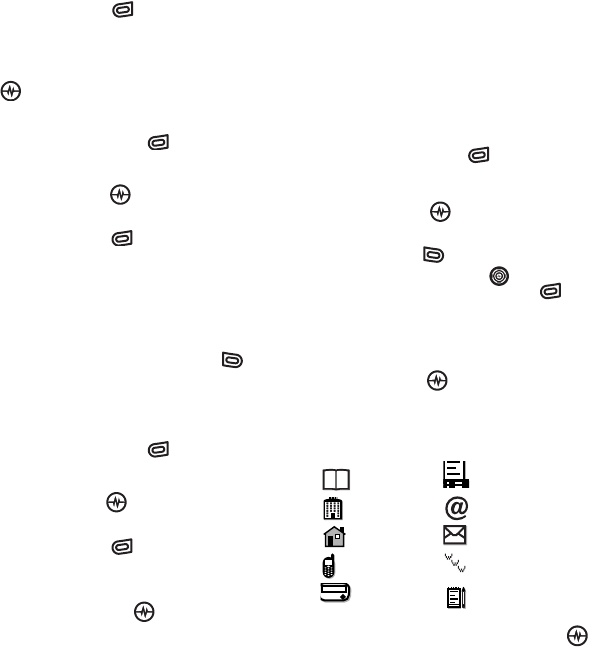
STORING CONTACTS Customizing your contacts PAGE 22
3. Highlight the contact name and press
the right softkey to select Options.
4. Select Ringer → Assign Ringer.
5. Scroll down the list to hear the different
ringers and press the Amp’d/OK key
to select one.
Assigning pictures
1. Press the right softkey to select
Contacts.
2. Highlight a contact and press the
Amp’d/OK key .
3. Highlight the contact name and press
the right softkey to select Options.
4. Select Picture → Assign Picture →
Images.
5. Select Saved Images, Wallpapers, or
Caller IDs.
6. Scroll through the list to view your
options and press the left softkey to
assign it to your contact.
Classifying contacts as Personal or
Business
1. Press the right softkey to select
Contacts.
2. Highlight a contact and press the
Amp’d/OK key .
3. Highlight the contact name and press
the right softkey to select Options.
4. Select Classify.
5. Select Personal or Business and press
the Amp’d/OK key .
Note: To assign Personal or Business ringers,
see “Assigning business and personal
ringers” on page 56.
Assigning number types
When you assign a number type, an icon is
placed in front of a contact number to
specify the type of number, such as work,
home, or mobile.
1. Press the right softkey to select
Contacts.
2. Highlight a contact and press the
Amp’d/OK key .
3. Highlight the contact number and press
the left softkey to select Edit.
4. Press the Navigation key down
once and press the right softkey to
select Options.
5. Highlight an option to designate the
number as General, Work, Home,
Mobile, Pager, or Fax and press the
Amp’d/OK key . You can also add
email addresses, street addresses, Web
page URLs, and a note. The associated
icon will appear next to the entry in your
Contacts directory and Recent Calls list.
general fax
work email address
home street address
mobile Web page
URL
pager note

PAGE 23 Editing a contact STORING CONTACTS
Editing a contact
1. Press the right softkey to select
Contacts.
2. Highlight a contact and press the
Amp’d/OK key .
3. Highlight the contact name or number
and press the left softkey to select
Edit.
4. Enter your changes and press the left
softkey to select Save.
Erasing a contact
1. Press the right softkey to select
Contacts.
2. Highlight the contact to erase and press
the Amp’d/OK key .
3. Select Options.
4. Highlight Erase Contact and press the
Amp’d/OK key .
5. Press the left softkey to confirm.
Sending a vCard
You can send contact information as a text
messages.
1. Press the right softkey to select
Contacts.
2. Highlight the contact to send as a
vCard and press the Amp’d/OK key
.
3. Press the right softkey to select
Options.
4. Highlight Send as vCard and press the
Amp’d/OK key .
5. Enter a recipient’s phone number and
press the left softkey to select Send.
Customizing a phone
number
1. Press the right softkey to select
Contacts.
2. Highlight the contact to edit and press
the Amp’d/OK key .
3. Press the Navigation key down to
highlight the contact number.
4. Press the right softkey to select
Options.
5. Highlight an option and press the
Amp’d/OK key :
–Add to Speed Dial assigns or
removes the speed dial location.
–Secret makes the number secret so
that it will not appear on the screen
until the lock code is entered. Secret
numbers can be called without a
lock code. (For more information,
see “Limiting calls” on page 62.)
–Primary Number makes this number
the first one that shows up when you
open the contact.
–Add Voice Dial to record a voice
tag so you can call a contact using
voice recognition (VR). For more
information, see page 83.
–Erase Voice Dial erases the voice
tag associated with the number.

STORING CONTACTS Finding contact information PAGE 24
–Edit Voice Dial records a new voice
tag.
6. Enter the new information and follow
the prompts.
7. Select Save, if necessary.
Finding contact information
To find a phone number or contact, you
can (1) check the Frequent list, (2) search
the Contacts directory, or (3) use Fast Find.
Checking the Frequent List
From the home screen, select Contacts.
The last 15 of your most frequently called
contacts appear when the Frequent List is
enabled. Scroll past the double line to view
the All Contacts list.
To enable the Frequent List setting
• Select Menu → Settings →
Convenience → Frequent List →
Enabled.
Searching the Contacts directory
1. Select Contacts for a list of all contacts.
To quickly get down the list, enter the
first letter of the contact. The menu skips
to that letter of the alphabet.
- or -
Select Menu → Contacts.
2. Select a search method:
–View All lists all saved contacts.
–Find Name locates a specific name.
Enter part of the contact name then
select Find.
–Speed Dial List, Voice Dial List,
Messaging Groups, Business List, or
Personal List selects a contact from
the specified list.
3. Highlight a contact and press the
Amp’d/OK key .
– To call the contact, highlight the
number and press the Send/Talk key
.
Setting Fast Find
With Fast Find, you press one or two keys to
view close matches of the number you are
looking for.
• Select Menu → Settings →
Convenience → Fast Find → Enabled.
Using Fast Find
1. From the home screen, press the keys
corresponding to the letters of the
name you want to find. A matching
contact or speed dial entry appears.
2. Press the Navigation key down to
scroll through matching entries.
3. Highlight the name you want then press
the Send/Talk key to call the
number.

PAGE 25 USING THE CAMERA
5 USING THE CAMERA
Tips before operating your camera
• You cannot activate the camera while
on an active call or while browsing files
in the media gallery.
• Once the camera is active, the home
screen acts as the viewfinder.
• If you get a “Low memory” error, check
your resolution and quality compression
settings. See “Setting up the camera”
on this page.
• If there is no activity within 45 seconds
after you turn your camera on, the
camera quits and returns to the
previous launch point.
• Menu settings and options can only be
accessed when the camera is active.
Accessing camera and
video modes
The camera can be used with the slide
open or closed.
Slide closed
• Press the camera button on the side of
the phone until you hear one beep
to activate camera mode.
• Press camera button on the side of the
phone until you hear two beeps to
activate video mode.
Slide open
• Press the internal camera key (on the
upper right of the internal keypad
until you hear one beep to activate
camera mode.
• Press internal camera key until
you hear two beeps to activate video
mode.
Setting up the camera for
photos
1. With the camera on, press the right
softkey to select Options.
2. Press the Amp’d/OK key to select
Settings.
3. Highlight an option and press the
Amp’d/OK key :
–Flash options are On, Off, or
Automatic.
–Resolution options are 640 x 480, 320
x 240 (best for sending to email), and
160 x 120.
–Low Light Mode brightens the picture
for low light environments.
–Self Timer options are Off (default) or
3, 5, or 10 second pauses. When set,
the camera beeps from 3 seconds
down to the time the shutter snaps
the picture automatically. Self Timer

USING THE CAMERA PAGE 26
is not available when Multishot
mode is activated.
–Multishot allows you to take up to six
multiple pictures while the camera
key is pressed and held. A tone will
play each time a picture is taken. A
second tone will play when the final
picture is taken.
–Shutter Sound sets the sound used
when the camera takes a picture.
–White Balance allows the camera to
adjust for different lighting. Options
are Automatic, Fluorescent,
Incandescent, or Daylight.
–Quality sets the picture compression.
The higher the compression, the
better the detail of the picture
(higher pixel rate). Options are Low,
Medium, or High (default). When set
to High, the picture file size is larger,
using more memory.
–LED flashes a light to indicate a
picture has been taken. Options are
On (default) and Off.
–Viewfinder display options are
Fullscreen and Actual.
–Save Location options are Save to
Card and Save to Phone.
Restoring camera menu settings
The following settings revert to the default
setting each time you enter and exit the
camera application:
– Low Light Mode, Self Timer, MultiShot,
Viewfinder Display.
The following settings remain at the setting
you selected each time you enter and exit
the camera application:
– Flash, Resolution, Shutter Sound,
White Balance, Quality, LED, and
Save Location.
Menu options for camera
mode
1. Press internal camera key or the
external camera key to activate
camera mode. Press and hold the
internal camera key or the external
camera button to activate video
mode.
2. Select Options.
3. Press the Navigation key up or
down to scroll through the options on
the vertical menu bar:
–Settings displays available camera
settings you may set up prior to
taking a picture.
–Video Mode toggles between video
and camera modes.
–Brightness allows you to adjust the
brightness of the image in the home
screen LCD.
–Camera Pictures displays all pictures
taken and stored.
–Last Picture displays the most
recently taken picture.
–Frames allows you to add a frame or
a stamp to your picture. A frame or
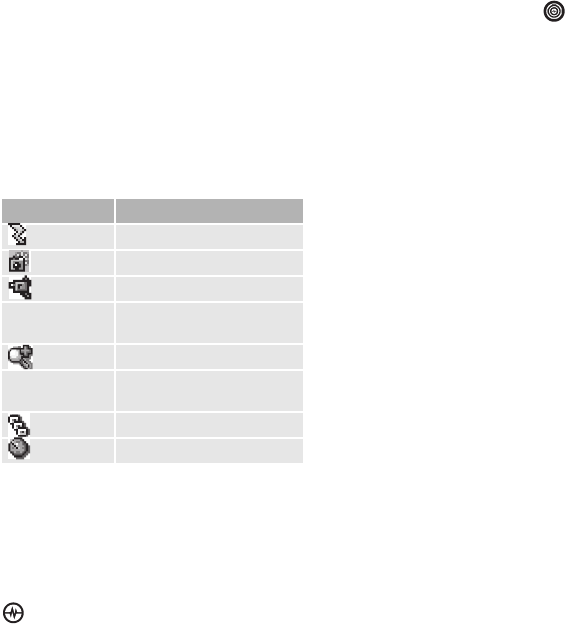
PAGE 27 Taking a picture USING THE CAMERA
stamp cannot be removed once it
has been used in a picture.
Note: The picture resolution changes to
160 x 120 while taking pictures with
frames. The resolution returns to the
original setting once the Frames option
is disabled.
Camera mode indicators
and icons
The camera mode displays the following
onscreen indicators and icons:
Taking a picture
Slide open or closed
1. Select Menu → Camera.
2. Focus on the image using the phone’s
display as the viewfinder.
Tip: Press the Navigation key up or
down to zoom in or zoom out.*
* You can only use zoom when the
camera is set to a resolution of 320 X 240
or below.
Icon Description
Flash on
Camera mode
Video mode
Top right
numbers
Number of snapshots
remaining
Zoom level*
Bottom left
numbers Resolution setting
Multishot
Self Timer
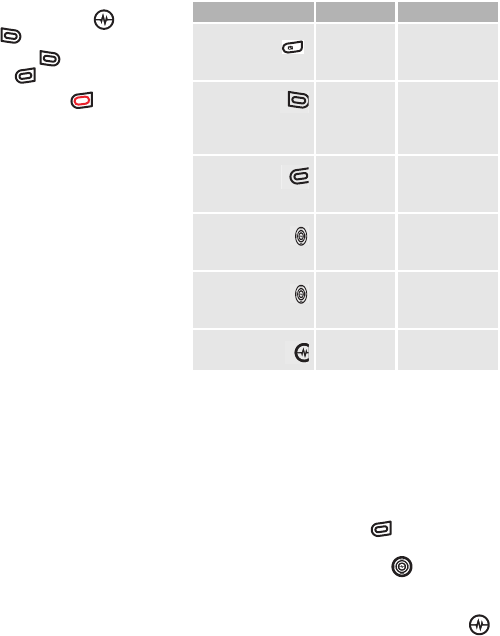
USING THE CAMERA Camera key map PAGE 28
3. Take the picture using one of two
methods:
– Press the Amp’d/OK key or the
left softkey .
4. Press the left softkey to select OK or
the right softkey to select Erase.
5. Press the End/Power key when
finished taking pictures.
Camera key map
Setting up the video camera
Menu settings can only be accessed when
the camera mode is activated.
To start video mode:
1. Select Menu → Camera.
2. Press the right softkey to select
Options.
3. Press the Navigation key up or
down to scroll through the vertical
menu bar.
Key Camera Menu Screen
Internal
camera
key
Take
picture
Dismiss menu
options
Left
softkey
Select
Capture
to take
picture
Select OK.
Right
softkey
Select
Options
Cancel,
dismisses
menu
Navigation
key Up
Zoom in* Scroll menu
options right
Navigation
key Down
Zoom
out*
Scrolls menu
options left
Amp’d/
OK key
Takes
picture
Select menu
option

PAGE 29 Recording a video USING THE CAMERA
4. Highlight Video Mode and press the
Amp’d/OK key .
or
– Press and hold until you hear two
beeps.
Menu options for video
mode
1. Once in Video Mode select Options.
2. Press the Navigation key up or down
to scroll through the vertical menu bar
and choose an option:
–Settings allows you to change your
camera settings. See “Setting up the
camera for photos” on page 25.
–Camera toggles between video and
camera modes.
–Brightness allows you to adjust the
brightness of the image in the home
screen LCD.
–Video Album displays all the videos
recorded and stored.
–Last Video plays the most recently
recorded video.
Recording a video
When you begin recording, a tone sounds,
the video record icon blinks, and a
“Recording” indicator with a timer progress
bar displays. A tone sounds when the video
stops recording.
Once in Video Mode:
1. Focus on the image and press the left
softkey to select Record.
Tip: Press the Navigation key up or
down to zoom in or zoom out.
2. If you want to pause the recording,
press the right softkey to select
Pause. To continue recording, press the
right softkey again to select
Resume.
3. When finished recording, press the left
softkey to select Stop.
4. The recorded video is immediately
saved to Media Gallery → Videos →
Video Album.
5. Press the back key or the End/
Power key when finished taking
videos.

USING THE CAMERA Recording a video PAGE 30
Video key map
Key Video Camera
Function
Menu
Function
Left softkey
“Record” – starts
recording toggle
(plays a tone)
“Stop” – stops
recording toggle
(plays a tone)
“OK” –
selects
option
Right
softkey
“Options” – while
not recording
“Pause/Resume” –
pauses and
resumes recording
toggle
“Close” –
dismisses
menu
Back key
When not
recording, goes
back to the last
function.
While recording,
stops recording.
Dismisses
menu
options
End/Power
key
Exit to idle when
not recording.
Exit to
idle
Navigation
key up
Zoom in Scrolls
menu
options
up
Navigation
key down
Zoom out Scrolls
menu
options
down

PAGE 31 What is Amp'd Live? AMP’D LIVE
6AMP’D LIVE
What is Amp'd Live?
Amp'd Live is your gateway to another mobile dimension. Imagine being able to view
music videos, listen to MP3s, subscribe to e-zines, read your favorite Blog, download
ringtones, wallpaper, and much more right to your phone. Well dream no more, it's all just a
button press away when you use Amp'd Live with your Amp'd Mobile service.
Amp'd Live lets you browse or search for all
kinds of stuff, you can preview items to
check them out before you buy them, and
then download the items you like to your
phone. Any items you buy or subscriptions
you sign up for are billed directly to your
Amp'd Mobile account, so you don't even
need to enter a credit card number to
amp your life!
What can I do?
The Amp'd Live main menu is set up by
topic so it's easy to find things that interest
you. Here's what you can expect to find
under each topic.
What's Hot
This stuff is straight out of the incubator, and
don't expect to see the same things the
next time you stop by. Look under What's
Hot for:
•Daily video, including new video
releases and other must-see flicks.
•Hot bundles that let you match your
phone to your unique personality.
•Artist features that put an artist in the
spotlight.
•Trend setting products to amp up your
phone.
•Sizzling applications that give you the
cutting edge.
•Other cool stuff for your viewing
pleasure.
Customize Amp’d Live
This is the place to go when you want to
personalize your phone. You can find the
latest:
•Ringtones that change the sound of
your phone when it rings. (Bet you
already knew that!) But, did you know
you have an almost endless list of song
choices?
•Wallpaper that change the home
screen background on your phone. We
have every kind of image you can
imagine from the wild to the sublime.
•Screensavers that appear while you're
not using your phone. They're just like
the screensavers on your computer and

AMP’D LIVE What is Amp'd Live? PAGE 32
we have some mind-bending
animations.
•UI Skins that redecorate everything on
the screen including menus, title bars,
icons, and the background of all the
screens. They're kind of like your
computer’s color themes on steroids.
•Featured bundles that include all of the
above items as a package deal.
Bundles usually have a theme, such as
a your favorite football team or pop-
star, and the featured ringtone,
wallpaper, screensaver, and skin all
relate to that bundle's theme.
Music
This is where you can turn your phone into
an MP3 player. You've got to check out
these:
•Top Sellers — including the top 100
songs (sorted by title, artist, or genre)
and the top 20 music videos
•Billboard Top 20 — featuring Billboard's
top 20 songs of the week
•New Releases — stay on top of what's
new this week
•Search Music — when you need to find
a specific genre, artist, song, or music
video
•Performances — for music videos from
your favorite channels including MTV,
AOL Music, IMF, VH1, CMT, and
MusicChoice
•Music News — keep an eye on the
music news of the week from sources
like Blender, Rolling Stone, and VIBE
•Community — stay in touch with
Blognet and MUSIC ID.
•Live Events — tap into on-the-spot
broadcasts of concerts and other music
events.
Sports
Look here if you can't wait to find out who
won that last game. The selection is
unbelievable:
•ESPN — it's the real deal, need we say
more?
•FOX Sports — yep, we got both of them
•Sports Illustrated — we're not leaving
any of the big guys out in left field
•Pro Leagues — stay on top of your
favorite teams including NFL, MLB, NBA,
and NHL
•Fighting — vicariously throw a few
punches, including UFC, Fox Sport
Boxing, and ESPN Friday Night Fights
•Speed — keep your adrenaline going,
including AMA Motocross, Import Tuner,
NHRA, Speedvision
•Action Sports — keep you moving,
including iFilm Plays of the Day, ASP
Live, Wave Watch (Surf Cams), Thrasher,
Snowboarder, Surfer, Surfing,
Skateboarder, Bike, Powder, SG, and
FUEL
•Fantasy — exercise your dreams (well
the sports ones anyway), including
Sports Chat, End Zone Attack, Office
Pool Pro Football, Hoop It Up, and Slug It
Out Baseball

PAGE 33 What is Amp'd Live? AMP’D LIVE
•Danny Sheridan — tells it all, including
Danny Sheridan Odds and Danny
Sheridan Office Pool
•Live Events — tap into on-the-spot
broadcasts of games, races, fights, and
other sporting events
Entertainment
Make this your first stop when you're ready
to turn your phone into a portable media
center. Honestly, check out the channels:
•Viral Videos — feed your hunger for sick
humor, including Big-Boys.com, College
Humor, and iFilm.com
•Movies — rescue the bored, including
Movies to Go, and iFilm.com Movie
Trailers
•TV — watch your favorite shows without
TIVO, including popular programs from
ABC, E!, NBC, Cartoon Network, WB,
CBS, UPN, MTV, VH1, CMT, Comedy
Central, BET, LOGO
•Internet — keep connected with a
Mobile Web Browser and mobile
versions of sites such as AOL, MSN,
Yahoo!, The Smoking Gun, eBay Mobile,
The Onion, MapQuest, Pogo.com,
MySpace.com, and Blognet.com.
•Entertainment News — keep up on all
the latest gossip, including E! News
Daily, Access Hollywood, The Onion,
National Enquirer, and Entertainment
Weekly
•Stand Up — keeps you smiling, including
Comedy Time, HBO Comedy Festival,
America's Best Mobile Fix, and Just For
Laughs
•Animation — for the graphically
inclined, including Marvel, DC, and
Mobile Comics Network
•The Vault — spark your desire, including
uncensored versions of Jerry Springer,
Blind Date, and Wild On! as well as
Playboy, Hustler, Wicked Pictures, Digital
Dreamgirls, Vivid, Peach, Perfect 10,
Girls Gone Wild, Playgirl, and the list
goes on. And if that isn't enough, there's
also after dark gaming titles
•Live Events — tap into on-the-spot
broadcasts of entertainment events
Games
This is a gamers dream. Look at all the ways
you can stay in the zone:
•Top Sellers — feeds your fix with EA and
Gameloft titles like 3D Madden 2005, 3D
Need for Speed, 3D Sled Storm, Vans
Skate & Salm 3D, Tom Clancey's Splinter
Cell: Chaos Theory 3D, King Kong 3D,
and many more
•Games Connect — launches a browser
for online gaming
•Action — gives you choices like Alias 3D,
Fight For Fallujah, 3D Independence
Day, Johnny Crash, Tokyo Fighter, Tak III,
and many more
•Sports — tests your skill with
snowboarder Travis Rice 3D,
3D Motocross, Pro Football Fantasy Five,
3D Tony Hawk Underground, to name
just a few

AMP’D LIVE Find stuff PAGE 34
•Arcade — provides classics like
Pacman, Ms Pacman, Space Invaders,
Galaxian, Galaga, Dig Dug, Snood 2,
Pitfall: Glacier and Jungle, Joust 2, and
Defender 2
•Casino — puts you against the odds at
Blackjack, Poker, Roulette, Video Poker,
Slots (1, 2 & 3), Scratch Ticket (1, 2 & 3),
HiLo, Virtual Horseracing, Keno, and
Bingo
•Strategy — sizes you up with Donald
Trump's Real Estate Tycoon, 3D Pool,
Backgammon, Othelo, Chess,
Cribbage, Reversi, and Mahjong
•Puzzle — makes you think with TV Guide
Crosswords, Trivia, Word Search,
Cryptogram, HangMan, and, MetroGirls
to name just a few
•Lifestyle — keeps you on your toes with
3D Pet Care (Tamagotchi), Buzztime Bar
Trivia, Stack-Um, Diva Dee Dancing,
Mahjong Puzzle, Breakout Bears,
Message In A Garden, and Bubble
Ducky
•Games For Prizes — gives you a chance
to be a real winner!
Messaging & Blogs
This makes text messages look like snail
mail. Now you can really stay in touch.
•IM no matter where you are: AOL, MSN,
and Yahoo
•Chat with interesting (and not so
interesting) people with Power Chat, Air
Chat, and 3D Island
•Mail <NEED INPUT>
•Blogs that are too cool to miss at
Blognet.com
News & Lifestyle
Look here when you're trying to figure out
how they fit all the hippest news and tips
inside your phone.
•News & Info — keeps you informed with
Astrology Zone, NBC News, ABC News,
Lottery, and Finance
•Find It — shows you the ropes with
Buddy Finder, SpotMe, Point-2-Point
Directions, Zagats, Weather, Vindigio
City Guide, MapQuest, Traffic Reports,
and Movies to Go
•Dating — flutter your heart with
Hurrydate, Fast Flirting, and Flirt Pix
•Magazines — keeps you in style,
including Star, Maxim, Stuff, InStyle,
Glamour, and GQ
•Health & Fitness — keeps you in shape
with Wireless Workouts and Food
Network
Find stuff
There are two ways to find stuff in Amp'd
Live, you can browse through items by
category, or you can search for a specific
item.
As you look at items, you'll also want to
know what the rating codes mean (see
page 35).

PAGE 35 Try before you buy AMP’D LIVE
Browse through items
As you explore the Amp'd Live world, you'll
see that it's pretty easy to get around.
1. Press Select (that's the Center of the
Navigation key ) to open Amp'd
Live.
2. Select an item from a menu, and then
choose an item from a list of choices.
3. If there's more than one level of
choices, select an item from the next
list.
Search for something specific
If you know exactly what you're looking for,
you can use the Search command to track
it down — instead of browsing through the
menu choices.
1. Go to Amp'd Live.
2. Select Menu → Search.
3. Select the type of item you want to find
(wallpaper, ringtone, screensaver, etc.).
4. If you see a select category box,
choose the category where you expect
to find the item you're looking for.
5. Enter a description of the item.
6. Select Search.
If you don't find it the first time, try again
and enter a different description of the
item or look in a different category.
Note: To find items that are similar to other
items, go to MyStuff, select the item with
which you want to compare things, select
Menu → Get More.
Decode the ratings
Whether you're looking for some sizzling
adult action or something you can show
your mother, you don't have to guess when
it comes to ratings. All the Amp'd Live items
have a rating decal.
Here's what the ratings mean:
•AA = All Audiences — even your
grandma won't find this stuff offensive.
•GC = General Content, which may
include mild language, violence, comic
mischief, and/or suggestive themes.
•MC = Mature Content, which may
include strong language, depictions of
violence, sex, and/or substance abuse.
•AO = 18+ Adult Only, which may
include uncensored depictions of
violence, nudity, or sex.
Enter adult areas
If you're over 18 and your age was verified
when you activated your phone, you
received a PIN that lets you enter the adult
vaults in the Internet, Entertainment, and
Game areas. If you didn't get a PIN and
you want to access the vaults, contact
Amp'd Mobile Customer Care.
Try before you buy
Nobody likes to buy stuff they won't use.
That's why we let you check things out
before you buy them.

AMP’D LIVE Send items to friends PAGE 36
1. Go to Amp'd Live.
2. Find an item you want to try.
3. Select Preview. If you pick a bundle,
you can preview each of the items in
the bundle.
4. If you like the item, select Buy. If you
don't like the item or you want to check
out some other choices before you
decide, press Back to keep looking.
Buy stuff
When you find something you like, the next
step is to choose how you to want buy it.
Depending on how you want to use the
item, you may want to choose a different
method for each item you buy (bundles
count as one item). The blurbs on the
screen tell you how much each item costs.
Here are some typical choices for buying
items:
•Download puts a copy of the item on
your phone so you can view or play it
whenever you want. There are no limits
on the number of times you can view or
play it on your phone or computer, but
copy protection rules still apply, so you
may not be able to share it with your
friends.
•Rental/ Stream plays the entire item on
your phone. You can view or play the
item only once. It's just like a pay-per-
view movie from your cable or satellite
service. If you want to share it with your
friends, make sure they're near by when
you select this option.
•Subscription gives you unlimited access
to the item during your subscription
period. Subscriptions are billed monthly
and they're a great way to check out a
lot of different stuff. Keep in mind that
the subscription items change often
(think e-zine or premium channel), so if
you find something you've got to have,
it's a good idea to buy that item and
download it.
Note:
If a download is interrupted, you can
finish the download later by pressing
Menu →
My Account
→ Pending Download
.
Send items to friends
Have you ever had one of those moments
where you thought "I have got to show this
to…."? Well, if your friends are also hooked
into the Amp'd Mobile network, and you
find something you want to share, you can
send items to your friends.
1. Go to Amp'd Live or MyStuff.
2. Find an item you want to share.
3. Go to the screen where you can buy
that item.
4. Select Menu → Send2Friend.
5. Enter your friend's phone number
(including area code).
6. Press the Send/Talk key .
Note: If you're friends aren't on the Amp'd
Mobile network, show them what they're
missing and tell them how to amp up their
lives!

PAGE 37 Enjoy Your Stuff AMP’D LIVE
Enjoy Your Stuff
After you download or subscribe to an
item, you go to the My Stuff area to play
your music, videos, and games, as well as
to run your applications and personalize
your phone stuff.
To get to the MyStuff area:
1. Press Select (that's the Center of the
Navigation key ) to open Amp'd
Live.
2. Press the Navigation key left to
open MyStuff.
Play music
After you download or start a music
subscription, you use the Media Player to
play your songs.
Pick your songs
You have several ways to pick the songs
you want to play:
1. Go to MyStuff → Music.
2. Select the method you want to use to
play your songs:
–Shuffle plays all the songs on your
phone in random order.
–Artist displays an alphabetical list of
the artists with songs on your phone,
so you can pick which artist you
want to hear. After you pick the
artist, you can then choose to hear
all songs by that artist or a specific
album or song.
–Album displays an alphabetical list
of the albums on your phone, so you
can pick which album you want to
hear. After you pick the album, you
can then choose to hear all songs
on the album or a specific song.
–Song displays an alphabetical list of
the songs on your phone, so you can
pick which songs you want to hear.
–Genre displays a list of the song
genres on your phone, so you can
pick which genre you want to hear.
After you pick the genre, you can
then choose to hear all songs in the
genre or a specific song.
–Playlist displays a list of the playlists
on your phone, so you can pick
which playlist you want to hear. After
you pick the playlist, you can then
choose to hear all songs in the list or
a specific song.

AMP’D LIVE Enjoy Your Stuff PAGE 38
Search for a song
If you're looking for a specific song, you
can use search for it instead of picking the
song from the Music menu categories.
1. Go to MyStuff → Music → Menu →
Search Catalog.
2. Select Music as the type of item you
want to find.
3. Select Song if you're looking for a song
title, or select Artist if you're looking for
songs by a particular performer.
4. Enter a description of the item.
5. Select Search.
Note: If you don't find it the first time try
entering a different description of the item
or check a different category.
Drive the Media Player
After you find the song(s) you want to play,
use the Media Player to control playback.
•Play/Pause — Press the Navigation key
up to play a song. While a song is
playing, press the Navigation key
up to pause it, and then to continue
playing it, press the Navigation key
up again. If your phone is closed, press
the Walkie-talkie (PTT) button (on the
left side) instead.
•Stop — Press the Navigation key
down to turn off the song. The next time
you play the song, it starts at the
beginning instead of picking up where
you left off.
•Next — Press the Navigation key
right to jump ahead to the next song.
•Restart — Press the Navigation key
left to restart a song from the beginning.
•Previous — Press the Navigation key
left twice to jump back to the previous
song.
•Fast-Forward — Press and hold the
Navigation key right to scroll ahead
in the song. If your phone is closed,
press the right softkey instead.
•Rewind — Press and hold the
Navigation key left to scroll
backward in the song. If your phone is
closed, press the End/Power key
instead.
•Volume — Press the volume key on the
side of the phone to make the
sound softer or louder.
Note: When streaming a song, you cannot
use these Media Player controls: Next,
Restart, Previous, Fast-Forward, or Rewind.
Organize your songs
MyStuff includes a built-in playlist called
MyList. You can change MyList by adding
songs, deleting songs, and moving songs
right on your phone. If you want more than
one playlist, you can create and manage
other playlists on your computer, and then
copy them to your phone, but you can't
change your extra playlists on your phone.
You can only change MyList on your
phone.

PAGE 39 Change PhoneStuff AMP’D LIVE
Add a song to MyList
1. Go to MyStuff → Music.
2. Find the song you want to add. (See
“Pick your songs” on page 37 or
“Search for a song” on page 38 for
details.)
3. Press Menu → Add2MyList.
Delete or move a song in MyList
1. Go to MyStuff → Music → Playlist →
MyList → Menu.
2. Select one of these commands to make
your changes:
–Move Up moves the current song up
one slot in MyList.
–Move Down moves the current song
down one slot in MyList.
–Delete removes the current song
from MyList. <<QUERY: Is this correct,
or does Delete remove the song
from the phone?>>
Play videos
You can use the Media Player to play
videos you download and your video
subscriptions.
1. Go to MyStuff → Video.
2. Select the category where you expect
to find the video you want to play.
3. Select the title or subscription you want
to play.
4. Use the Media Player controls to play
the video. See “Drive the Media Player”
on page 38 for details.
Play games
When you're ready to play a game you
downloaded or subscribed to, you get to it
from MyStuff.
1. Go to MyStuff → Game.
2. Select the category where you expect
to find the game you want to play.
3. Select the title or subscription you want
to play.
4. Press Select to start the game.
Run applications
When you're ready to run an application
you downloaded, subscribed to, or
installed from your computer or a memory
card, you get to it from MyStuff.
1. Go to MyStuff → Application.
2. Select the category where you expect
to find the application you want to run.
3. Select the title or subscription you want
to run.
4. Press Select to run it.
Change PhoneStuff
PhoneStuff is where you go to personalize
and decorate your phone from the inside
out. This is where you set ringtones,
wallpaper, skins, and screensavers.
1. Go to MyStuff → PhoneStuff.

AMP’D LIVE Launch subscriptions PAGE 40
2. Select the type of item you want to
change.
3. Select the item you want to use.
4. Press Select to preview the item or press
Assign to use it.
Note: To stop a preview before it finishes,
press OK/Back.
Back up skins
You can protect your purchases and save
space on your phone by backing up your
skins to a memory card.
1. Go to MyStuff → PhoneStuff → Skins.
2. Select the item you want to back up.
3. Press Menu → Backup.
Delete skins
After you back up a skin to a memory card,
you may want to delete it to make room for
another download. If you don't back up a
skin before deleting it, you'll need to buy it
again if you ever want to reload it.
1. Go to MyStuff → PhoneStuff → Skins.
2. Select the item you want to delete.
3. Press Menu → Delete.
4. Press OK to confirm deletion.
View or load skins from a memory
card
If you backed up a skin to a memory card,
you can preview it and reload onto your
phone.
1. Go to MyStuff → PhoneStuff → Skins →
Menu → Memory Card.
2. Select the item you want to view or
load.
3. Press Select to preview the skin or select
Assign to use it.
Launch subscriptions
When you're ready to view or play an item
you subscribed to, you can get to it from
the related MyStuff category (music, video,
games, etc.) or you can easily get to all
your subscriptions in one place.
1. Go to MyStuff → Subscription.
2. Select the subscription you want to view
or play.
3. Press Select to launch it.
Cancel a subscription
If you decide you don't want one of your
subscriptions anymore, you can
unsubscribe right from your phone. No
phone calls or letters required here.
1. Go to MyStuff → Subscription.
2. Select the subscription you want to
cancel.
3. Select Menu → Unsubscribe.
4. Press OK to confirm cancellation.

PAGE 41 Cancel a subscription AMP’D LIVE
Use menu commands
Most of the MyStuff menu commands are explained in other parts of this guide, but we've
put them all here for easy reference.
This command... Does this...
Add2MyList Adds the selected item to MyList.
Unsubscribe Cancels the subscription for the selected item.
Delete Deletes the selected item from MyList or your phone (depending on
the current selection).
Send2Friend Lets you enter send items to friends on the Amp'd Mobile network.
All you need to do is enter your friend's phone number.
Get More Finds other items that are similar to the selected item.
Shuffle Plays the current playlist in random order.
Properties Shows details for the current item, such as Title, Artist, Album, Genre,
Rating, and Price.
Search Catalog Lets you look for music by artist or title, and look for videos by
category and title.
Home Takes you to the MyStuff main menu.
Help Shows you helpful hints and explanations for the current screen.
Now Playing Takes you to the Media Player when music is playing in the
background.

AMP’D LIVE Need Help? PAGE 42
Need Help?
Here are some suggestionf for getting help
with your Amp'd Mobile phone.
FAQ's
Here are a few commonly asked questions
and answers:
Is there a quick way to get back to the
Amp'd Live or MyStuff main menu?
• Select Menu → Home.
How do I finish a download that was
interrupted?
1. Go to Amp'd Live.
2. Select Menu → My Account →
Pending Download.
Why can't I get into The Vault?
You must be at least 18 years old and have
a PIN code to enter The Vault. If you didn't
provide age verification when you
activated your phone, or you turned 18
since you purchased your phone, contact
Amp'd Mobile Customer Care to arrange
for age verification and to get a PIN code.
Why can't I send stuff to a friend?
Make sure your friend is on the Amp'd
Mobile network. You can't send ringtones,
pictures, videos, or any of the items you
download to anyone outside the Amp'd
Mobile network. You can still send pictures
you take with the built-in camera.
I picked Rental/Stream, why can't I restart
or replay the item?
You can view or play Rental/Stream items
only once. It's just like a pay-per-view movie
from your cable or satellite service. If you
want to use an item more than once,
select Download instead.
How do I edit my playlists?
Although you can play the playlists you
create on your computer from your phone,
you can't change them on your phone.
You can edit only the built-in MyList playlist
from your phone. You need to edit your
other playlists on your computer and then
put an updated copy on your phone.
Where can I see details about an item?
1. Go to MyStuff.
2. Select the item which details you want
to see.
3. Select Menu → Properties.
How do I cancel a subscription?
1. Go to MyStuff → Subscription.
2. Select the subscription you want to
cancel.
3. Press Menu → Unsubscribe.
4. Press OK to confirm cancellation.
Get Help Online
To get help online, go to
www.ampdmobile.com. <<NEED INPUT
HERE.>>

PAGE 43 Need Help? AMP’D LIVE
Customer Care
<<NEED INPUT HERE.>>

USING MEDIA GALLERY Accessing files PAGE 44
7 USING MEDIA GALLERY
The Media Gallery stores camera pictures, images, sounds, and videos in the phone and
displays those files on the phone’s screen.
Accessing files
1. Select Menu → Media Gallery.
2. Select an option:
–Camera Pictures displays thumbnails
of the photos you have taken in
chronological order.
–Images displays a list of categories
that contain preloaded,
downloaded, saved, or created files
such as wallpaper, screen savers, or
caller IDs.
–Sounds displays a list of categories
that contain saved or downloaded
sounds such as ringers and voice
memos.
–Videos displays a list view of the file
names of videos that you recorded.
Browsing images
The images menu allows you to assign your
files to various applications.
1. Select Menu → Media Gallery →
Images.
2. Highlight an option and press the
Amp’d/OK key :
–Saved Images displays available
images.
–Wallpapers displays wallpaper
selections.
–Screen Saver displays available
screensavers.
–Caller IDs displays pictures and
images saved and the text IDs you
assigned them.
3. Press the left softkey to select View
(for saved images, screen saver, caller
ID) or OK (for wallpapers).
4. Press the left softkey to select Send
and launch the multimedia messaging
application.
- or -
Press the right softkey to select
Options (options vary according to
selection):
–Send launches the messaging
application so you can share the
image.
–Set as Default to assign the image as
a wallpaper or screen saver.
–Assign to assign the image to a
contact.
–Erase the image (image must not be
locked).
–Details gives you the file size of the
image.
–Erase All erases all images stored
(images must not be locked).

PAGE 45 Accessing files USING MEDIA GALLERY
–Rename the image.
5. Select Close or press the back key
when done.
Browsing pictures
1. Select Menu → Media Gallery →
Camera Pictures.
2. Highlight a picture and press the left
softkey to select View.
3. Press the left softkey to select Send
and launch the multimedia messaging
application.
- or -
Press the right softkey to select
Options:
–Assign picture as a Caller ID or
as wallpaper.
–Modify allows you to rotate, resize,
change brighness, sharpness,
saturation, hue, auto adjust color
tone.
–Zoom allows you to zoom in or out on
the picture.
–Take Picture to snap another photo.
–Lock to prevent accidentally erasing
the photo.
–Rename the photo.
–Move File
–Copy File
–Erase All
Browsing sounds
1. Select Menu → Media Gallery →
Sounds.
2. Highlight an option and press the
Amp’d/OK key :
–Saved Sounds contains sounds
saved on your phone.
–Music contains preloaded songs
(not available on all phones, check
with your service provider.)
–Ringers contains ringers saved on
your phone.
–Voice Memos contains voice
memos you made to yourself.
3. Highlight an option and press the
Amp’d/OK key (options vary
according to selection):
–Play to review the sound.
–Record New allows you to record
new sounds.
–Erase the videos.
–Lock to prevent accidentally erasing
the sound.
–Rename allows you to rename the
sound file.
–Details gives you the file size of the
sound.
–Erase All erases all sound stored.
4. Select Close when done.
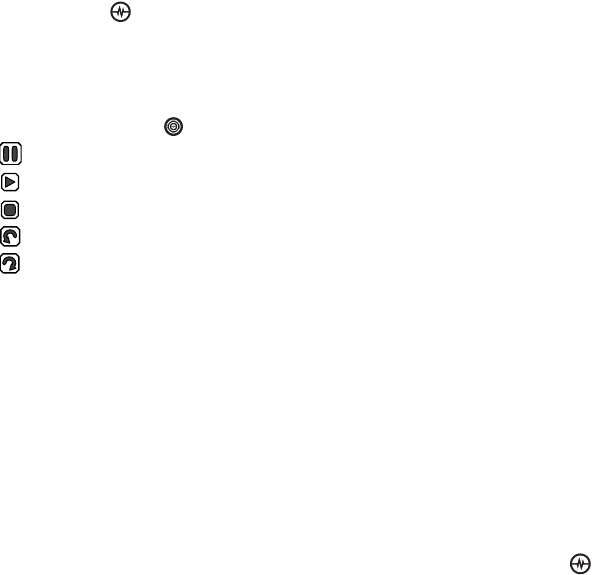
USING MEDIA GALLERY Accessing files PAGE 46
Browsing videos
1. Select Menu → Media Gallery →
Videos.
2. Highlight an option and press the
Amp’d/OK key :
–Video Album contains videos taken
with your camera.
–Saved Videos contains videos that
were downloaded.
3. Select Play to review a video.
Use the Navigation key to highlight:
- or -
Select Options and choose from the
following options:
–Send launches the messaging
application so you can share the
videos.
–Record New allows you to record
new videos.
–Erase the videos.
–Lock to prevent accidentally erasing
the video.
–Rename allows you to rename the
video file.
–Details gives you the file size of the
video.
–Move File allows you to move a file.
–Copy File allows you to copy a file.
–Erase All erases all videos stored.
4. Select Close when done.
Pause
Play
Stop
Rotate Left
Rotate Right

PAGE 47 USING PUSH TO TALK
8 USING PUSH TO TALK
The Push to Talk (PTT) feature on your Kyocera Jet/Angel phone allows you to quickly
communicate with an individual or group. Once connected, simply press and hold the
walkie-talkie button to communicate.
Note: The PTT feature on this phone can be
used only with compatible PTT phones.
Phone position
When using your phone as a walkie-talkie
radio, hold the phone in a vertical position
one to two inches (2.5 to 5 cm) away from
your mouth.
Speakerphone
PTT calls come through the speakerphone
by default. The loudspeaker is located on
the back of your phone.
•Call waiting: If you accept any type of
call through call waiting, the incoming
call sound will be the same as the sound
of the call you are in already. For
example, if you are on a cellular call
using the earpiece and you accept an
incoming PTT call, the sound for the PTT
call will come through the earpiece.
•Headset: If a headset is connected to
the phone, PTT calls come through the
headset speaker, and you speak
through the headset microphone. You
are required to press the walkie-talkie
button to gain floor control of a PTT call
and speak to other parties. (Headsets
are sold separately.)
Adjusting PTT call volume
•To adjust speakerphone volume while
on a PTT call — Press the volume key on
the left side of the phone up or down
during the call.
•To make a PTT call come through the
earpiece — Press the speakerphone
button during a call.
To cancel, press the speakerphone
button.
•To make a PTT call come through the
earpiece and silence ringers — From
the home screen, select Menu →
Settings → Silent Mode and select a
vibrate or lights setting.
To cancel, either press the
speakerphone button or select
Menu → Settings → Silent Mode →
Normal Sounds.
The speaker icon at the top of the
phone screen indicates that the
speakerphone is on. Press the
speakerphone button inside
the slider to turn it off.

USING PUSH TO TALK PTT call types PAGE 48
PTT call types
You can make two types of walkie-talkie
calls:
•A PTT call automatically connects to the
other party. The receiving party does
not have the option to ignore the call. It
can be
–a private PTT call to a single PTT user,
or
–a group PTT call to more than one
PTT user.
•A Call me alert sends the receiving
party a text message and a message
alert beep to indicate that someone
wants to speak with them. The receiving
party has the option to either answer or
ignore the call. Call me alerts are
private calls only.
Making PTT calls and alerts
Making a private PTT call
1. There are five ways start a private PTT
call:
– Enter a 10-digit phone number
(including area code), then press
the walkie-talkie button.
– From the home screen, press the
walkie-talkie button to open the
Push to Talk menu. Highlight a
contact or group, then press the
walkie-talkie button.
– Select Menu → Push to Talk →
PTT Contacts and search for a saved
PTT contact. Highlight the contact
and press the walkie-talkie button.
– Select Menu → Contacts→ PTT
Contacts. Highlight the contact and
press the walkie-talkie button.
– Select Menu → Recent Calls, select
a list (Incoming Calls, Outgoing
Calls, or Missed Calls), highlight a
call, and press the walkie-talkie
button.
2. Listen for the “Ready to Speak” tone
(three rapid chirps).
3. Speak while pressing the walkie-talkie
button.
4. Release the walkie-talkie button when
finished speaking. This allows the called
party to reply.
5. Wait for the “Ready to Speak” tone,
then press the walkie-talkie button
again to speak.
6. To end the PTT call, press the End/Power
key or the Amp’d/OK key . If the
other party ends the call, no action is
required.
Tip: If you originate a call to a person
who is actively engaged in a cellular
call or a PTT call, you hear the “Ready
to Speak” tone and your voice
message is stored. The other party can
choose to answer or ignore the new
incoming call. If they answer the call,
they will hear your voice message, and
then you and the other party will hear

PAGE 49 Making PTT calls and alerts USING PUSH TO TALK
the “Floor Free” tone (a single high-
pitched beep).
Making a group PTT call
A group must be saved before you can call
it. To save a group, see page 52.
1. Select Menu → Push to Talk →
PTT Groups.
2. Highlight the group you want to call.
3. Press and hold the walkie-talkie button.
When the audio path is ready and the
group is available, the “Ready to
Speak” tone sounds.
4. Speak your message while continuing
to press the walkie-talkie button.
5. Release the button when finished
speaking your message. This allows the
group members a chance to reply.
6. Press the walkie-talkie button again to
speak.
7. To end the PTT call, press the End/Power
key or the Amp’d/OK key .
Sending a Call me alertCall me alert
You can send an alert only to a contact
that is saved in your PTT Contacts list. The
recipient can choose to ignore the alert or
accept it and start a PTT call with you.
Start at the home screen.
1. Press the walkie-talkie button.
- or -
Select Menu → Push to Talk →
PTT Contacts.
2. Scroll through the list and highlight the
PTT contact you want to call.
3. Press the left softkey to select Send
Alert.
“Sending alert.” appears on your
screen, then you return to the previous
screen.
The receiving party’s phone beeps and
a message appears on the phone
screen.
There is no time-out period. The alert will
remain on their screen until they accept
or ignore it.
4. If the recipient accepts the alert, you
will hear their voice through your
phone. Press the walkie-talkie button
and wait for the “Ready to Speak” tone
(three rapid chirps).
5. Speak your message while continuing
to press the walkie-talkie button.
6. Release the button when finished
speaking your message. This allows the
group members a chance to reply.
7. Press the walkie-talkie button again to
speak.
8. To end the PTT call, press the End/Power
key or the Amp’d/OK key .

USING PUSH TO TALK Receiving PTT calls and alerts PAGE 50
Receiving PTT calls and
alerts
Receiving a PTT call
When your phone receives a private or
group PTT call, the caller’s voice sounds
through the speakerphone and the phone
makes the “Open Floor” tone.
In a private call, “PTT Call” appears on the
screen with the caller’s contact name or
phone number.
In a group call, “PTT Group Call” appears
with the name of the group.
1. Press and hold the walkie-talkie button.
2. Listen for the “Ready to Speak” tone
(three rapid chirps).
3. Speak while pressing the walkie-talkie
button.
4. Release the walkie-talkie button when
finished speaking. This allows another
party to reply.
5. Wait for the “Ready to Speak” tone,
then press the walkie-talkie button
again to speak.
6. To end the PTT call, press the End/Power
key or the Amp’d/OK key . If the
other party ends the call, no action is
required.
Receiving a Call me alert
When your phone receives a Call me alert,
the phone beeps. The name or phone
number of the caller appears on the screen
with the message “<name /phone
number> requests a PTT call. Please press
the Walkie-Talkie button.”
• To ignore the alert, press the left softkey
to select Ignore.
• To accept the alert and call the person,
press the walkie-talkie button.
Saving, editing, and erasing
PTT contacts
Adding a PTT contact
You can add new PTT contacts and view
their presence in the PTT contacts directory
using the main PTT menu.
Note: The potential contact will be notified
and must give permission before you can
save their phone number as a contact.
1. Select Menu → Push to Talk →
PTT Contacts.
2. Press the right softkey to select
Options.
Note: When you are adding your first
PTT contact, you will be asked “No PTT
Contacts. Add New?” Press the left
softkey to select Yes.
3. Press the Amp’d/OK key to select
Add New Contact.
4. Enter the PTT contact number.
5. Press tne Navigation key down and
enter the PTT contact name.

PAGE 51 Saving, editing, and erasing PTT contacts USING PUSH TO TALK
If you do not enter a contact name, the
contact phone number will appear on
your phone instead of a name.
6. Press the left softkey to select Save.
The message, “Sending request...”
appears.
– If the PTT contact number is valid
and the other party accepted your
request to be added, “Contact
Name Added” appears.
– If the other party refused your
invitation or did not respond within a
3-minute period, “Contact Name
Not Added” appears.
Note: The other party cannot receive or
respond to your invitation if their phone
is off or if they are outside of the service
area.
7. If “Contact Name Not Added”
appears, press the left softkey to
select OK and return to the PTT menu.
Erasing a PTT contact
1. Select Menu → Push to Talk →
PTT Contacts. Highlight the PTT contact
name you wish to erase.
2. Press the right softkey to select
Options.
3. Press the Navigation key down to
select Erase Contact.
4. Press the left softkey select Yes, or
press the right softkey to select No.
5. To erase additional contacts, press the
Navigation key up or down and
select their names and repeat the
process above.
Checking your contacts’ availability
In the Recent Calls lists and the PTT menus,
icons appear next to PTT contact and
group names to show their availability to
participate in a call.
.Checking and settin g your avai lability
Available—A bold PTT icon means the
contact (or one member of the group)
can accept calls.
Do Not Disturb—The PTT icon with an X
means that PTT calls cannot be made
to the contact (or any member of the
group).
Off-Line—A dim PTT icon means the
handset is turned off, or the contact is
not registered with the voice network.
Contact or group Member is available
Contact or group Member is not
available
Contact or group Member is set to
DND (do not disburb)
Contact or group Member is
temporarily unavailable
Contact or group Member is in
pending (originator)
Contact or group Member is in
pending (terminator)
Contact or group Member is in state
unknown (awaiting server update
Group is available

USING PUSH TO TALK Saving, editing, and erasing PTT groups PAGE 52
Regardless of how you set your availability
(presence), you can still make PTT calls.
1. Select Menu → Push to Talk →
My Availability.
2. Select an option:
–Available allows you to make and
receive PTT calls.
–Do Not Disturb ensures that you will
not receive PTT calls.
Note: You can set a shortcut to the
My Availability option to make it
accessible with one keypress from the
home screen. (See “Creating and
updating your custom menu” on page 58.)
Saving, editing, and erasing
PTT groups
You can create up to 30 PTT groups with up
to 30 members per group. The total number
of contacts saved in your phone (including
PTT and non-PTT contacts and groups)
cannot exceed 99. You can create a PTT
group from a list of contacts in another
group or add new contacts to a group
from scratch.
Note: To establish a group, your phone
must be provisioned by your service
provider.
1. Select Menu → Push to Talk →
PTT Groups.
2. Press the left softkey to select New.
3. Enter the new group name using the
phone’s keypad. See page 18 if you
need help entering text.
4. Press the left softkey to select Next.
The Select Contacts screen appears.
5. Highlight the name of the PTT contact
you want to add to your new group
and press the Amp’d/OK key . A
check mark appears beside the
contact name.
Note: The PTT contact must be
provisioned from the handset or a Web
interface before the contact can be
added to a group.
6. If no PTT contact names appear, or if
the desired contact is not on the list,
then press the right softkey to select
Options.
7. Press the Amp’d/OK key to select
Add New.
8. Enter the phone number of the PTT
contact name to be added to the
group.
9. Press the Navigation key down to
the Enter Name field.
10. Enter the name of the PTT contact to be
added, using the phone’s keypad.
Group is not available
Group is set to DND, all users in the
group have presence of DND
Group is Pending (originator)
Group is Pending (terminator)
Group member state is unknown

PAGE 53 Saving, editing, and erasing PTT groups USING PUSH TO TALK
Note: If the contact is already in your
Contacts directory, then the name is
automatically stored.
11. Press the left softkey to select Save.
12. When you are finished adding PTT
contacts to your newly created group.
13. When you are finished creating a new
group and adding members to it,
invitations are sent to the members
asking for their permission to join your
newly created group.
Tip: The invitation includes your name or
number and the group name, but does not
list all invited members of the group. After
accepting an invitation, the new member
can select the group name and view the
list of members.
Adding a member to a PTT group
1. Select Menu → Push to Talk →
Manage Groups → Add Member. The
Select Group screen appears. Press the
Navigation key up or down to
highlight the group to which you want
to add the new member.
2. Press the Amp’d/OK key . The Add
Member screen appears. Highlight the
name of the new member that you
want to add to the group.
Note: If no PTT contact names appear,
or if the desired contact is not on the list,
then perform steps 5 through 9 of
“Creating PTT Groups” on page 52.
3. Press the Amp’d/OK key to choose
Select. A check mark appears beside
the contact name.
4. Press the Navigation key right to
highlight Save and press the Amp’d/OK
key . Your phone sends an invitation
to the members you have added to the
group.
Editing a PTT group name
You can edit names only of groups that
you created.
1. Select Menu → Push to Talk →
PTT Groups.
2. Highlight the PTT group name you wish
to change.
3. Press the right softkey to select
Options.
4. Press the Navigation key down to
select Edit Group Name.
5. Edit the group name using the phone’s
keypad. See page 18 for help entering
text.
6. Press the left softkey to select Save.
All members in your group are notified
and updated.
Erasing a PTT group
You can only erase PTT groups that you
created.
1. Select Menu → Push to Talk →
PTT Groups.
2. Highlight the PTT group name you wish
to erase.
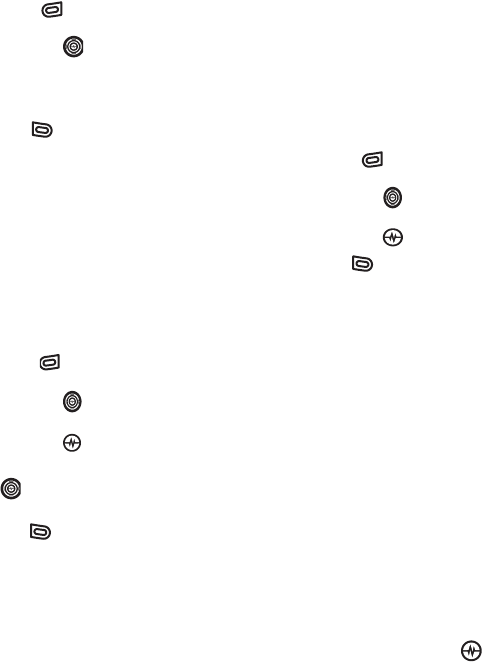
USING PUSH TO TALK Saving, editing, and erasing PTT groups PAGE 54
3. Press the right softkey to select
Options.
4. Press the Navigation key down to
select Erase Group.
5. The message “Erase Group <group
name>?” appears.
6. Press the left softkey to select Yes.
Note: Individual members of a PTT
group remain in the PTT contacts list
after the group is erased.
Erasing a PTT group member
You can erase PTT group members only
from groups that you created.
1. Select Menu → Push to Talk →
PTT Groups.
2. Highlight the PTT group name you wish
to edit.
3. Press the right softkey to select
Options.
4. Press the Navigation key down to
select Remove Member.
5. Press the Amp’d/OK key to insert a
check mark beside the contact name.
To erase additional members, press the
Navigation key up or down and
select their names.
6. Press the left softkey to select Done.
The message “Remove Member(s)?”
appears. Select Yes to erase the
member name, or No to discontinue
and return to the previous screen.
Removing yourself from a PTT group
You can remove yourself from a PTT group
that you did not create.
1. Select Menu → Push to Talk →
PTT Groups.
2. Highlight the name of the group you
want to leave.
3. Press the right softkey to select
Options.
4. Press the Navigation key down to
select Leave Group.
5. Press the Amp’d/OK key .
6. Press the left softkey to select Yes.
The message “Leave Group <group
name>?” appears.
7. Select Yes to leave the group, or No to
discontinue and return to the previous
screen. A message requesting that you
be removed from the group is sent to
your service provider. Your phone then
returns to the PTT menu.
Dealing with multiple calls
Your phone can handle two calls at the
same time. When you are on a cellular or
PTT call, you may receive or place another
cellular or PTT call at the same time.
Erasing PTT call history
PTT calls are included in the recent calls list
along with standard voice calls. See
“Erasing recent calls” on page 14 to erase
call history from your phone’s memory.

PAGE 55 Silencing all sounds CUSTOMIZING YOUR PHONE
9 CUSTOMIZING YOUR PHONE
Silencing all sounds
Your phone is set to make sounds when you
receive calls, press keys, navigate through
menus, and receive alerts (such as new
messages). You can silence all sounds and
set the phone to vibrate or light up when
you receive calls and alerts.
Setting the phone to vibrate or light up
1. Select Menu → Settings → Silent Mode.
2. Choose an option and press the
Amp’d/OK key :
–Vibrate Only: The phone vibrates for
the duration of the incoming call or
other alert. appears on the home
screen.
The contents of the Settings menu are as follows.
Silent Mode
Vibrate Only
Vibe then Ring
Lights Only
Normal Sounds
Keyguard
Guard On Close
Disabled
Sounds
Ringer Volume
Ringer Type
Business Ringer
Personal Ringer
Roam Ringer
Slide Open
Slide Closed
Pwr On/Off Sound
Key Volume
Key Length
Missed Call Alert
Smart Sound
Minute Alert
Earpiece Volume
Spkrphone Volume
Display
My Banner
Main Menu View
Color Themes
Wallpaper
Screensaver
Backlighting
Auto-Hyphen
Time/Date
Contrast
Brightness
Convenience
Airplane Mode
Open to Answer
Fast Find
Frequent List
Hold Call
1-Touch Dialing
Call Guard
Close to End
Memory Card
Items to Save
Format Card
Voice Features
Add Voice Dial
Erase Voice Dial
Voice Training
Voice Wake-Up
Voice Answer
Expert Mode
Messaging
Alerts
Signature
Edit QuickText
Auto Retrieve
Callback Number
Text Msg Receipt
Save to Sent
Auto-Erase
Default Text
Voicemail Number
Security
Lock Phone
Limit Calls
New Lock Code
Erase Contacts
Emergency Numbers
Network
Data/Fax Calls
Privacy Alert
Set Phone Line
Roam/Svc Alert
Roam Option
Location
Accessories
Pwr Backlighting
Headset Ringing
Auto-Answer
Com Port Speed
TTY Device
USB Mode
Music (MTP)
Mass Storage
Modem/COM

CUSTOMIZING YOUR PHONE Keyguard PAGE 56
–Vibe then Ring: The phone vibrates
for the first 10 seconds and then rings
for the remainder of the incoming
call alert. appears on the home
screen.
–Lights Only: The phone lights up for
the duration of the incoming call or
other alert. appears on the
home screen.
–Normal Sounds: The phone rings for
the incoming call or alert (in effect,
returns phone to a non-silent mode).
Note: The phone will ring when it is
attached to an external power source
(such as a charger), even if all sounds have
been silenced.
Shortcut to Vibrate Only mode
• Press and hold the Space # key .
Turning sounds back on
• Select Menu → Settings → Silent
Mode→ Normal Sounds.
- or -
Press and hold the Space # key .
Keyguard
1. Select Menu → Settings → Keyguard.
2. Select Guard On Close or Disabled.
• Press the Amp’d/OK key to
unlock.
Choosing ringers
Your Kyocera Jet/Angel phone has pre-
programmed ringers you can choose to
use for incoming calls.
1. Select Menu → Settings → Sounds →
Ringer Type.
2. Scroll down the list to hear the different
ringers and press the Amp’d/OK key
to select one.
Note: Downloaded ringers are added to
the end of the standard list of ringers.
Assigning business and personal
ringers
You can assign ringers to contacts
classified as business or personal in your
Contacts directory.
Note: To classify a contact as Business or
Personal, see “Classifying contacts as
Personal or Business” on page 22.
1. Select Menu → Settings → Sounds.
2. Highlight Business Ringer or Personal
Ringer and press the Amp’d/OK key
.
3. Select a ringer and press the Amp’d/OK
key .
Setting sounds for your
phone
You can set your phone to sound tones
when you open and close the slide and
when you turn the phone on and off.

PAGE 57 Adjusting volume CUSTOMIZING YOUR PHONE
Sounds will not occur during an incoming
call, if you are on a call, or if a headset or
car kit is attached to your phone.
Set sound when slide opens
1. Select Menu → Settings → Sounds →
Slide Open.
2. Scroll through the list to hear the sounds
and press the Amp’d/OK key to
select one.
Set sound when slide closes
1. Select Menu → Settings → Sounds →
Slide Closed.
2. Scroll through the list to hear the sounds
and press the Amp’d/OK key to
select one.
Set sound when phone powers on or
off
• Select Menu → Settings → Sounds →
Pwr On/Off Sound → Enabled.
– To not play a sound, select Disabled.
Adjusting volume
You can adjust the earpiece,
speakerphone, and ringer volume as well
as key tones.
Adjusting the earpiece volume
To adjust the earpiece volume manually
during a call, press the Navigation key
or the volume key on the side of the
phone up or down.
To set the earpiece volume:
1. Select Menu → Settings → Sounds →
Earpiece Volume.
2. Press the Navigation key right to
increase the volume or left to decrease
the volume and select Save.
Using smart sound
You can set a baseline volume that the
phone uses to automatically adjust the
earpiece volume when there is a change
in the amount of noise around you or the
caller’s voice.
• Select Menu → Settings → Sounds →
Smart Sound → Enabled.
Adjusting the ringer volume
1. Select Menu → Settings → Sounds →
Ringer Volume.
2. Press the Navigation key right to
increase the volume or left to decrease
the volume and select Save.
Adjusting speakerphone volume
1. Select Menu → Settings → Sounds →
Spkrphone Volume.
2. Press the Navigation key right to
increase the volume or left to decrease
the volume and select Save.
Adjusting key tone volume
You can change the volume of the tones
the phone makes when you press the keys.
1. Select Menu → Settings → Sounds →
Key Volume.

CUSTOMIZING YOUR PHONE Setting message alerts PAGE 58
2. Press the Navigation key right to
increase the volume, or left to decrease
the volume and select Save.
Setting key length
You can change duration of the tones the
phone makes when you press the keys.
1. Select Menu → Settings → Sounds →
Key Length.
2. Choose Normal or Long and press the
Amp’d/OK key .
Setting message alerts
You can choose how you want be alerted
of incoming voicemail, pages, or text
messages.
1. Select Menu → Settings →
Messaging → Alerts.
2. Select the type of alert and press the
Amp’d/OK key :
Message Alert, Page Alert, or
Voicemail Alert.
3. Select an option:
–Vibrate, Beep, Freeway, Game, or
Bloop sets the phone to vibrate,
beep, or play a tune once when a
new message is received.
–Options with Remind set the phone
to notify you once when a new
message is received and then notify
you again every five minutes. To stop
a reminder alert, press the Amp’d/
OK key to select Ignore.
–Disabled turns off message alerts.
Using shortcuts
From the home screen, press the
Navigation key in one of four directions
to access four shortcuts and one custom
menu.
Creating and updating your custom
menu
You can create a custom menu that
contains your favorite features. After you
set up your menu, simply press and hold the
Navigation key up to access it.
1. Press and hold the Navigation key
up to launch Custom Menu.
2. Select Manage List.
3. Scroll through the available options and
press the Amp’d/OK key to select
or deselect options.
Up Access your Custom Menu
Down Launch Messaging
Left Launch Amp’d Live - My
Stuff
Right Launch Amp’d Live - Media
Player
Right 2X Resume Music playback if
interrupted.

PAGE 59 Personalizing the screen CUSTOMIZING YOUR PHONE
–You may select more than one
feature. Items appear in
alphabetical order in the menu.
4. Select Save changes.
Personalizing the screen
Changing your banner
Your personal banner appears on the
home screen above the time and date
and can be up to 14 characters long.
1. Select Menu → Settings → Display →
My Banner.
2. Select Edit.
3. Press the back key to clear the
screen.
4. Enter your new text. See
“Understanding text entry screens” on
page 18.
5. Select Save.
Choosing a menu view
You can change the appearance of your
phone’s menus:
1. Select Menu → Settings → Display →
Main Menu View.
2. Select an option and press the Amp’d/
OK key :
–Graphic displays icons of each
menu item, with its name at the
bottom of the screen.
–List displays a list of each menu item.
–Wheel displays a rotating graphic
image of the menu items.
3. Press the End/Power key to return
to the home screen. The next time you
select Menu, you will see the menu view
you selected.
Adjusting the backlighting
Your screen lights up while you are in a call
or when you press a key on the keypad.
However, you can set the duration and
brightness of backlighting.
1. Select Menu → Settings → Display →
Backlighting → Duration.
2. Select an option and press the Amp’d/
OK key :
–7 seconds, 15 seconds, or 30
seconds turns backlighting on for 7,
15, or 30 seconds after your
last keypress.
–7 sec. & in call, 15 sec. & in call, or 30
sec. & in call turns backlighting on
for the duration of a call and for 7,
15, or 30 seconds after your
last keypress.
Note: The “in call” settings drain the
battery more quickly.
Using Power Save Mode
You can conserve battery life by activating
Power Save mode. The backlighting
appears for the selected duration, but is
less bright than with Power Save off.
• Select Menu → Settings → Display →
Backlighting → Pwr Save Mode → On.

CUSTOMIZING YOUR PHONE Personalizing the screen PAGE 60
Setting power backlighting
You can set backlighting to remain on
when an external power source, such as
the AC adapter, is used with the phone.
Note: Power backlighting may not be
available with the optional desktop
charger or other accessories.
• Select Menu → Settings →
Accessories → Pwr Backlighting →
Always On.
– To disable this feature, select
Normal.
Note: The battery charges more slowly
when power backlighting is on.
Changing the display contrast
1. Select Menu → Settings → Display →
Contrast.
2. Press the Navigation key left or right
to adjust the contrast and select Save.
Changing the brightness
1. Select Menu → Settings → Display →
Brightness.
2. Press the Navigation key left or right
to adjust the brightness and select
Save.
Setting numbers to auto-hyphenate
Auto-hyphenation, when enabled,
automatically inserts hyphens into your
phone numbers to be consistent with the
U.S. dialing plan.
For example, 1-222-333-4444.
• Select Menu → Settings → Display →
Auto-Hyphen → Enabled.
Selecting a screensaver
Screensavers appear on the home screen
when the slide is open and are activated
10 seconds after the last keypress.
Incoming calls and alerts override screen
savers.
1. Select Menu → Settings → Display →
Screensaver.
2. Highlight a screen saver and press the
Amp’d/OK key . The image
appears.
3. Press the left softkey to assign the
screen saver.
4. Press the right softkey to return to
the home screen and wait 10 seconds
to view the selected screen saver.
Note: Downloaded screen savers are
added to the end of the list.
Selecting wallpaper
Wallpaper appears as background on the
home screen.
1. Select Menu → Settings → Display →
Wallpaper.
2. Highlight a wallpaper design and press
the Amp’d/OK key .
3. Select Assign to save your selection.

PAGE 61 Creating a secure environment CUSTOMIZING YOUR PHONE
Selecting a color theme
You can select a color theme for the
display background of your phone.
1. Select Menu → Settings → Display →
Color Themes.
2. Scroll through the options to view the
color themes and press the Amp’d/OK
key to select one.
Choosing a different time/date format
1. Select Menu → Settings → Display →
Time/Date Format.
2. Highlight an option pressthe Amp’d/OK
key .
Creating a secure
environment
This section describes all the features
involved in securing your phone and
preventing access to personal information.
All security features are shielded by a four-
digit lock code.
Changing your lock code
The lock code is typically 0000 or the last 4
digits of your phone number.
1. Select Menu → Settings → Security.
2. Enter your four-digit lock code.
3. Select New Lock Code. A message
appears: “Change Code?”
4. Select Yes and enter a new four-digit
code.
5. Enter your new lock code again.
Locking your phone
When your phone is locked, you can call
only emergency numbers or your service
provider’s number. You can still receive
incoming calls.
1. Select Menu → Settings → Security.
2. Enter your four-digit lock code.
3. Select Lock Phone.
4. Highlight an option and press the
Amp’d/OK key :
–Never does not lock the phone.
–On power up locks the phone every
time you turn it on.
–Now locks the phone immediately.
Unlocking the phone
1. From the home screen, press the left
softkey to select Unlock.
2. Enter your four-digit lock code.
Designating emergency numbers
The emergency numbers feature allows
you to specify three personal phone
numbers that can be called when the
phone is locked.
1. Select Menu → Settings → Security.
2. Enter your four-digit lock code.
3. Select Emergency Numbers.
4. Select an Unassigned slot.

CUSTOMIZING YOUR PHONE Network settings PAGE 62
5. Enter the phone number, including the
area code. Do not enter 1 before the
area code.
6. Select Done.
Notes:
• You can view these numbers only when
they’re being entered for the first time.
• To make a call to an emergency
number from a locked phone, you must
dial the number (including area code)
exactly as it was stored in Emergency
Numbers.
Limiting calls
You can limit the calls that can be made
from your phone to emergency numbers,
your contacts, and service provider
numbers.
1. Select Menu → Settings → Security.
2. Enter your four-digit lock code.
3. Select Limit Calls.
4. Choose an option and press the
Amp’d/OK key :
–No Limit limits no calls.
–Limit Outgoing calls only. Incoming
calls can still be received and
answered.
–Limit All limits both incoming and
outgoing calls.
Erasing all contacts
You can erase all entries in your Contacts
directory.
1. Select Menu → Settings → Security.
2. Enter your four-digit lock code.
3. Select Erase Contacts.
4. Select Yes to erase all contacts. A
message appears: “Erase ALL
Contacts?”
5. Select Yes again to erase all contacts.
Network settings
Switching between phone lines
Your phone can have two service
accounts, or phone lines, associated with it.
Each phone line has its own phone
number.
When you are using one line, you cannot
receive calls from the other. It would be as
if the phone were “off” for that number.
Your voicemail, however, will still take
messages. All contacts and settings are
shared for both lines.
Note: You must first establish a second
phone line with your service provider.
Once established, a second phone
number becomes available in the menu
for selection.
1. Select Menu → Settings → Network →
Set Phone Line.
2. Select one of the two lines and press
the Amp’d/OK key .

PAGE 63 Setting position location CUSTOMIZING YOUR PHONE
Connecting to a TTY/TDD device
You can connect the phone to a TTY
device for the hearing impaired.
Note: Enable TTY only when using the
phone with a TTY device.
1. Connect the TTY device to the phone.
2. Enter #/space, #/space, 8, 8, 9 (
) on
your keypad.
3. Select the TTY option.
4. Press the Amp’d/OK key to clear the
message.
5. Highlight an option and press the
Amp’d/OK key .
Note: TTY/TDD service may not be
available. Check with your service provider
for more information.
Setting position location
This setting allows you to share your
location information with network services
other than emergency services (911, 111,
999, 000, etc.) in markets where service has
been implemented.
Note: You do not have the option of
turning off the locator to emergency
services.
1. Select Menu → Settings → Network →
Location.
2. Select 911 Only or Location On.
–911 Only (default) shares your
position information only with
emergency services when you call
your 3-digit emergency code (911,
000, 111, etc.).
–Location On shares your position
information with your service
provider’s network in addition to
emergency services.
USB Mode
This setting allows you to change the
phone’s default behavior when the USB
cable is connected to an external device.
Refer to page 52 for details.

MUSIC, VIDEO, AND DATA Removable memory card PAGE 64
10 MUSIC, VIDEO, AND DATA
Your Kyocera Jet/Angel phone phone supports a memory card for mass storage (of Music
and Video, for example).
Removable memory card
Your Kyocera Jet/Angel phone uses a
removable memory card that, when
inserted into the phone, increases storage
capacity. You can drag and drop files
stored on your computer directly onto the
card.
The removable memory card supports
mp3, aac, mp4, 3gp, 3g2, m4a, and m4b
file types, up to 512 MB.
Protected files may be copied to the card,
but will not play properly if not supported.
Formatting the memory card
Before you can listen to music through your
Kyocera Jet/Angel phone phone , you will
need to initialize the TransFlash memory
card (optional accessory). The memory
card can be formatted automatically or
manually.
Automatic
Note: Formatting or reformatting a
memory card erases all data and music
files that were previously saved on the
TransFlash memory card.
1. Lift the TransFlash cover up. (See item 18
in the picture on page 5).
2. Hold the card with the metal contacts
facing up and push the card in the slot
until it clicks into place.
3. Close the cover.
4. The phone will automatically begin to
format the card and “Card now ready
for use.” appears after completion.
5. Once the TransFlash card has been
formatted, you can place (drag and
drop) your music files onto the card.
Manual
Note: Formatting or reformatting a card
erases all data and music files that were
previously saved on the TransFlash card.
1. Lift the TransFlash cover up. (See item 19
in the picture on page 5).
2. Hold the card with the metal contacts
facing up and push the card in the slot
until it clicks into place.
3. Close the cover.
4. Select Menu → Settings → Memory
Card → Format Card.
5. Press the left softkey to select Yes
and format the card.
6. The message “Card now ready for use.”
appears after completion.

PAGE 65 USB Mode MUSIC, VIDEO, AND DATA
USB Mode
The Kyocera Jet/Angel phone supports
three types of USB modes:
•Music (MTP) mode (default) allows
transfer of music files between devices.
•Mass Storage mode allows you to copy
songs from your PC onto your
removable MicroSD card. Your Kyocera
Jet/Angel phone will automatically
detect when your phone requires a
specific USB mode.
•Modem/COM mode supports hands
free kits.
Setting the USB mode
You can set the default USB Mode to
automaticaly connect in the mode you
prefer:
1. Select Menu → Settings → USB Mode
and choose from:
–Music (MTP) (default)
–Mass Storage
–Modem/COM
2. Press the Amp’d/OK key to select.
Music (MTP) mode
When you leave Music (MTP) as the default
USB Mode, the type of device your phone is
attached to will be automatically
detected.
1. Using the supplied USB cable, connect
your Kyocera Jet/Angel phone to a
target device, such as a laptop or
desktop computer.
2. The type of device to which you have
connected your phone will determine
what mode the phone automatically
defaults to:
– Connection to a PC with a
TransFlash card inserted defaults to
Music mode.
– Connection to a PC without a
TransFlash card inserted defaults to
Modem/COM mode.
– Connection to a device that does
not support MTP defaults to Mass
Storage mode.
Note: Do not remove the TransFlash card
or USB cable while transferring files.
Mass Storage mode
When you set Mass Storage as the default
USB Mode, the type of device your phone is
attached to will be automatically
detected.
1. Using the supplied USB cable, connect
your Kyocera Jet/Angel phone to a
target device, such as a laptop or
desktop computer.
2. The type of device to which you have
connected your phone will determine
what mode the phone automatically
defaults to:
– Connection to a PC with a
TransFlash card inserted defaults to
Mass Storage mode.

MUSIC, VIDEO, AND DATA USB Mode PAGE 66
– Connection to a PC without a
TransFlash card inserted defaults to
Modem/COM mode.
Modem/COM mode
When you set Modem/COM as the default
USB Mode:
1. Using the supplied USB cable, connect
your Kyocera Jet/Angel phone to a
target device, such as a laptop or
desktop computer.
2. The phone automatically defaults
Modem/COM mode.
Note: If you insert the TransFlash card while
the phone is operating in Modem/COM
mode, you will not automatically be
switched to Music or Mass Storage mode.
You must select the new mode manually,
or disconnect and reconnect the USB
cable.

PAGE 67 Sending text messages SENDING AND RECEIVING TEXT MESSAGES
11 SENDING AND RECEIVING TEXT MESSAGES
This chapter describes how to send, receive, and erase text messages from your phone. For
information on voicemail messages, see “Setting up voicemail” on page 15.
Sending text messages
You can only send text messages to
phones that are capable of receiving them
or to email addresses.
Creating a text message
1. Select Menu → Messages →
New Text Msg.
2. Enter a recipient’s phone number or
email address:
–Select Options to access your
Recent List, Contacts, or Group Lists
and press the Amp’d/OK key .
Select a contact and press the
Amp’d/OK key .
Highlight the number field and press
the Amp’d/OK key . For more
about group lists, see “Creating
group lists” on page 72.
- or -
–Enter a New Address manually.
(To learn how to enter text, see
Chapter 3, “Understanding text entry
screens” .)
3. Add another recipient if desired:
– Press the right softkey to select
Options then select Recent List,
Contacts, or Group Lists.
- or -
– Enter a space or comma after the
first number then enter another
recipient manually.
Note: You can send a message to up to
10 recipients at once. The messages will
be sent one at a time, once to each
addressee.
4. When you are done entering addresses,
press the Navigation key down, or
press the Amp’d/OK key twice.
5. Enter the message. To learn how to
enter text, see “Understanding text
entry screens” on page 18.
- or -
Add QuickText, symbols, or emoticons in
your message. See “Including
prewritten text and symbols” for
information.
6. Press the left softkey to select Send.
See “Setting sending options” for
information about how and when you
want the message to be received.
Including prewritten text and
symbols
During text entry, you can insert QuickText,
symbols, or smileys in your message.
1. From the text entry screen, select
Options.

SENDING AND RECEIVING TEXT MESSAGES Sending text messages PAGE 68
2. Select an option and press the Amp’d/
OK key :
–Insert QuickText: Scroll through the
list of options and press the Amp’d/
OK key to select one.
–Add Symbol: Scroll through the list
and press the corresponding
number key to select it.
–Add Smiley: Scroll through the icons
and press the corresponding
number key to select it.
3. When you have finished your message,
select Send. See “Setting sending
options” for information about how and
when you want the message to be
received.
Setting sending options
When you are ready to send a message,
you have several options for how and
when you want the message to be
received.
1. Once you have completed the
message, select Options:
–Add Address returns to the “Send To”
screen to add another recipient
without losing the message. Select
Options to access your Recent List,
Contacts, or Group Lists and press
the Amp’d/OK key .
Select a contact and press the
Amp’d/OK key . Highlight the
number field and press the Amp’d/
OK key .
–Save Message saves the message in
your Drafts folder. This prevents the
message from being deleted if you
have activated AutoErase and
enables you to send the message to
others.
–Save QuickText saves the message
you have just entered as a
prewritten message then returns to
the message entry screen so you
can send the message.
–Settings allows you to choose from
the following after pressing the
Amp’d/OK key :
•Msg Receipt to request
notification when the message
has been received.
•Set Priority labels the message as
“Urgent.”
•Callback Number includes a
callback number with the
message to let recipients know at
what number they can call you
back. Select OK to include your
own number or Edit to enter a
different callback number.
•Send Later schedules a time to
send the message.
2. When you have finished setting options,
press the back key to return to
the message window.
3. Press the left softkey to select Send.
Adding a signature
The signature you create is included at the
end of all outgoing messages and is
counted as characters in your messages;
however, it does not appear in the
message creation screen.
To create a signature:
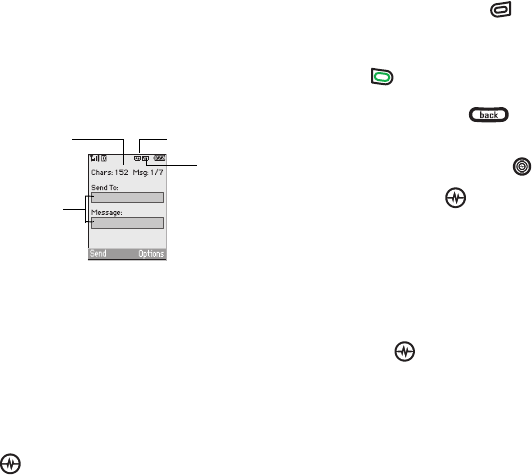
PAGE 69 Sending text messages SENDING AND RECEIVING TEXT MESSAGES
1. Select Menu → Settings → Messaging →
Signature.
2. Enter your signature in the text field.
3. Select OK to save the setting.
Note: The characters in the signature are
included in the total character count of
the message. See the note under step 5 in
“Creating a text message” on page 67.
If you cannot send messages
You may not be able to send or receive
messages if your phone’s memory is nearly
full, or if digital service is not available at
the time. To free up memory, erase old
messages.
Understanding appended messages
If you go over the character limit for a
single message, the phone may
automatically append an empty segment
to your message to make space.
Important: Your service provider will
charge you for each message segment.
When you start a message, the maximum
character limit appears once you are in the
message entry field. This number counts
down as you enter characters, until it
reaches 0. If you continue to enter text
after this counter reaches 0, a message
segment may be appended. When you
reach the message size limit, you are
prompted to edit the message or alerted
that the message is being appended.
Receiving incoming calls while
creating messages
• If you don’t wish to answer the call,
press the right softkey to select
Silence or Ignore. The phone returns to
the message screen.
• To answer the call, press the Send/Talk
key . Your message is saved to the
Drafts folder. To return to the message,
press the back key .
• To work on the message at a later time
select Menu → Messaging → Drafts ,
press the Navigation key up or
down to select the draft, then press the
Amp’d/OK key and select Resume.
Viewing your sent messages
To save your outgoing messages, you must
first enable Save to Sent.
1. Select Menu → Messages →
Msg Settings → Save to Sent.
2. Select an option and press the Amp’d/
OK key .
–Enabled automatically saves all
successfully sent messages in the
Sent folder.
text entry
fields
text entry mode
capitalization setting
characters
remaining
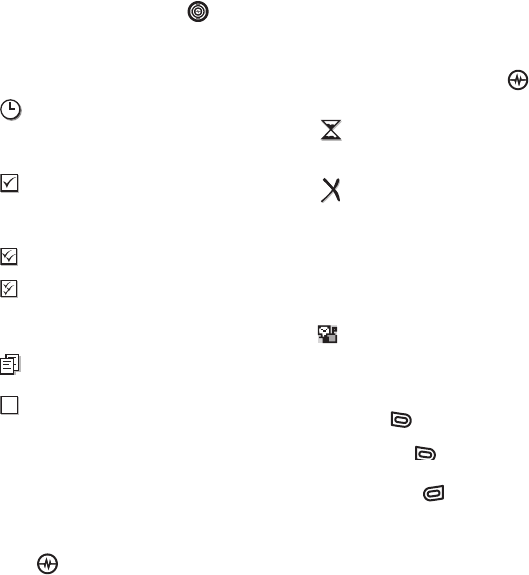
SENDING AND RECEIVING TEXT MESSAGES Retrieving text messages PAGE
–Prompt allows you to choose
whether or not to save your
message when you send it.
To view successfully sent messages:
1. Select Menu → Messages → Sent.
2. Press the Navigation key up or
down through the list of messages. One
of the following symbols appears next
to each message:
Viewing failed or pending messages
Failed or pending messages are stored in
your OutBox.
To view your OutBox:
1. Select Menu → Messages → OutBox.
A list of all failed or pending messages
appears.
2. Scroll through the list of messages and
press the Amp’d/OK key to read
one.
Retrieving text messages
When a text message is received, your
screen displays “New Messages” with the
symbol at the top of your screen.
The symbol flashes if the message is urgent.
If you see the “New Messages” note
• To view the message, press the left
softkey to select View Now,
highlight the message, and press the
left softkey to select View.
•To view the message later, press the
right softkey to select Later.
The scheduled message will be
sent at the scheduled time. You
cannot cancel delivery of the
message.
The scheduled message has been
sent and will be delivered as
scheduled. You cannot cancel
delivery of the message.
The message has been received.
The message has been received
and opened. (This symbol may not
be available. Check with your
service provider.)
The message has been sent to
more than one recipient.
The message has never been sent
or has not been sent since it was
last modified. You can cancel
delivery of the message.
The message is pending and will
be sent when possible. You can
cancel delivery of the message.
The message cannot be sent
because service is not available.
An alert appears on your phone if
the message cannot be sent.

PAGE 71 Retrieving text messages SENDING AND RECEIVING TEXT MESSAG-
Note: If you receive a new message while
you are reading a message, the one you
are reading will be replaced by the new
one. You can find the older message in the
InBox:
• Select Menu → Messages → InBox.
If you see the symbol
1. Select Menu → Messages → InBox. A list
of all your received messages appears.
– indicates an “Urgent” message.
2. Scroll through the list of messages and
press the Amp’d/OK key to read
one.
Reading the message
The options available to you may vary.
Check with your service provider.
Note: Sounds embedded in text messages
will not play if the phone is set to Silence All
mode.
1. If the text message is long, press the
Navigation key down to view the
entire message.
2. When you are finished, you can Reply
to the sender, Play the sound
embedded in the message, Erase the
message, Save the message to your
Saved folder, or set additional Options
for the message:
–Erase the message.
–Lock Msg to protect the message
from being accidentally deleted.
–Forward the message.
–Reply with Copy to reply to the
message with a copy of the original
attached.
–Save Message to save the message.
–Save as QuickText to save the text
from the message as QuickText,
which you can insert into other
messages. Graphics and sound are
not saved as part of QuickText.(For
more about QuickText, see
page 73.)
–View Sender information.
Note: The symbol indicates that a
graphic did not come through. It may be
too large or incorrectly formatted.
Setting message alerts
You can set your phone to alert you of
incoming text messages or pages. For more
information, see “<$Heading158.
Erasing messages
It is a good idea to erase old messages to
free up memory in your phone.
You have the option of erasing text
messages and pages as you send or read
them, erasing them one at a time from the
list in the OutBox or InBox, or erasing them
all at once.
Erasing single messages
1. Select Menu → Messages.
2. Select the type of text message you
want to erase: InBox, OutBox, Sent,
Drafts, or Saved.

SENDING AND RECEIVING TEXT MESSAGES Customizing message settings PAGE
3. Highlight the message to erase.
4. Select Options.
5. Select Erase to erase the message. A
notification appears: “Erase this
message?”
6. Select Yes to erase the message.
Note: You can erase a scheduled
message from the OutBox, but you cannot
cancel delivery of the message.
Erasing all messages
1. Select Menu → Messages → Erase
Messages.
2. Select a folder from which to erase all
messages: InBox, OutBox, Sent, Saved
Folder, Drafts Folder, or All Messages. To
erase messages from all folders, select
All Messages.
3. A message appears: “Erase all
messages?” Select Yes to erase
messages or No to cancel.
Erasing messages automatically
Use this setting to have old messages
automatically erased from the InBox when
memory is low.
• Select Menu → Messages → Msg
Settings → Auto-Erase → Old InBox
Msgs. Older messages will be erased as
new messages are received.
Customizing message
settings
To make messaging easier, you can
customize settings for sending and
receiving messages.
Creating group lists
You can create and save a list of multiple
recipients. Your Kyocera Jet/Angel phone
stores five group lists with up to 10 recipients
per list.
1. Select Menu → Messages → Group Lists
→ Create New.
2. Enter a name for the list. For help
entering text, see page 18.
3. Select Next.
4. To enter the first phone number or email
address, select an option:
–Recent List to select numbers from
your Recent List.
–New Address to enter the phone
number or email address manually.
–Contacts List to select numbers from
your phone book.
5. Locate the contact number and press
the Amp’d/OK key .
6. Select Options → Recent List or
Contacts.
7. Locate the contact number and press
the Amp’d/OK key .
8. When finished, select Done.

PAGE 73 Customizing message settings SENDING AND RECEIVING TEXT MES-
9. To send a message to your new group,
see “Sending text messages” on
page 67.
Creating and editing prewritten
messages (QuickText)
Your phone comes with prewritten
(QuickText) messages, such as “Please call
me,” which you can insert into the body of
a text message. You can edit these
messages and create new ones. Your
phone will store up to 40 QuickText
messages, with up to 100 characters per
message.
1. Select Menu → Messages →
Msg Settings → Edit QuickText.
2. To create a new pre-written message,
select New Msg.
-or-
To edit an existing pre-written message,
highlight the message and select Edit.
3. Enter or edit the text and press the left
softkey to select Done. For help
entering text, see Chapter 3,
“Understanding text entry screens” .
Note: You can also save a message you
have written or received as QuickText. See
“Setting sending options” on page 68 or
“Reading the message” on page 71.

SENDING AND RECEIVING MULTIMEDIA MESSAGES Sending multimedia
12 SENDING AND RECEIVING MULTIMEDIA MESSAGES
Sending multimedia messages
You can only send multimedia messages to phones that are capable of receiving them or
to email addresses. For details, check with your service provider.
Multimedia messages have a
predetermined character and file size limit.
When you reach the character and file size
limit for a single multimedia message, you
must edit the message to meet the size
limitation.
Note: Multimedia message file size limits
may apply. For details, check with your
service provider.
Creating a multimedia message
1. Select Menu → Messages →
New Pix Msg.
2. Enter the recipient’s phone number or
email address in the To: field.
3. To add additional recipients:
– Enter a space or comma after the
first phone number or email address,
then enter another recipient
manually,
-or-
– Press the right softkey to select
Options. Then select Contacts or
Group Lists.
Note: You can send one multimedia
message to a maximum of 10
recipients.
4. Press the Navigation key down
once to enter a message in the Subject:
field. Choose a method:
– Enter the subject text manually, or
– Press the right softkey to select
Options.
5. Press the Navigation key down
once or select Next to enter a brief text
message in the Text: field.
6. Press the Navigation key down
once to enter the
Image/Video: field.
Note: You may add only one picture or
one video per multimedia message.
7. Press the right softkey to select
Options. Select an option:
•Take Picture to instantly take a new
photo and attach it to your message.
•Media Gallery to access all picture and
video files in the phone:
–Camera Pictures displays your
photos taken in a table/thumbnail
view.
• Highlight a photo to add to the
multimedia message. Press the
left softkey to choose Select.

PAGE 75 Receiving multimedia messages SENDING AND RECEIVING MULTIME-
–Images displays stored images on
the phone.
–Video displays stored videos on the
phone.
8. Press the Navigation key down
once to enter the Sound: field and press
the right softkey to select Options.
Choose:
•Record Sound to instantly record a new
sound and attach it to your message.
•Media Gallery to display a list of
categories
that contain saved or downloaded
sounds and voice memos.
– Highlight Saved Sounds.
Press the left softkey to select
Open.
– Highlight a sound to add to the
multimedia message. Press the left
softkey to choose Select.
Note: You may add only one new or
stored sound per multimedia message
sent.
9. Before sending your message, press the
right softkey to select additional
Options. Choose:
–Preview Message plays your
multimedia message prior to
sending.
–Save Message allows you to save
your multimedia message to the
Drafts Folder and send it later.
–Add Address allows you to add
additional addresses to your
multimedia message prior to
sending it.
–Message Priority allows you to send
your multimedia message with
Normal or Urgent priority.
10. Press the left softkey to select Send.
This will send your multimedia message.
Receiving multimedia
messages
There are two settings for receiving a
multimedia message on your Jet/Angel:
Auto Receive (default) and Prompt.
Auto receive mode
When a multimedia message is received, it
is automatically downloaded onto your
phone.
The alert “New Message(s)” appears along
with the text “Message Received. View
now?”
•To View the multimedia message,
press the left softkey .
•To view Later, press the right softkey .
Note: If a multimedia message is received
during a call, then the phone downloads
the message approximately one minute
after the last key is pressed.
Prompt mode
When a multimedia message is received,
your screen displays the alert “New
Message(s)” along with the question
“Retrieve Now?”
•To View the multimedia message, press
the left softkey .

SENDING AND RECEIVING MULTIMEDIA MESSAGES Viewing multimedia
• Select Erase to never download the
multimedia message.
•To view Later, press the right softkey .
Note: If a multimedia message is received
during a call, then the phone screen
displays the alert “New Message(s)” after
the call ends.
To activate Prompt mode:
1. Select Menu → Messages → Msg
Settings.
2. Press the Navigation key up or
down to scroll through the list.
3. Highlight Auto Retrieve and press the
Amp’d/OK key .
4. Press the nev key up or down
through the list and highlight Disabled.
Press the Amp’d/OK key .
Viewing multimedia
messages
When you receive a multimedia message,
a voice text message icon appears on
your phone’s screen and remains until all
messages are viewed. The message is
stored in the InBox until the full message has
been received, regardless of the auto
receive or prompt setting.
1. Press the left softkey to View the
multimedia message. If the message is
long, press the Navigation key
down to view the entire multimedia
message.
2. Press right softkey to select Options.
Press the Navigation key down to
highlight
additional options for the multimedia
message (options vary according to
selection):
Note: The options available to you may
vary. Check with your service provider.
–Mute to silence the message.
–Erase Msg allows you to delete the
currently displayed multimedia
message.
–Forward launches the message
creation screen, allowing you to
forward the multimedia message.
The original address will not be
shown, nor will the graphic, sound,
and text fields.
–Lock Msg to avoid accidentally
erasing it.
–Message Info displays multimedia
message information (priority,
sender, subject, time sent and
received, and message size).
–Play Video plays the video in the
multimedia message.
–Replay plays the multimedia
message again from the beginning.
–Done exits the multimedia message.
–Call initiates call to sender of
multimedia message.
–Save Picture saves the currently
viewed picture embedded in the
multimedia message.

PAGE 77 Viewing multimedia messages SENDING AND RECEIVING MULTIME-
–Save Video saves the video
embedded in the multimedia
message.
–Save Sound saves the current sound
embedded in the multimedia
message.
–Save Address extracts email
addresses, phone numbers, and/or
URLs from the sender info and
multimedia message body.
–Save as QuickText saves the text in
the multimedia message to the
QuickText list.
–Save Message saves the multimedia
message to the Saved Folder on the
phone.
3. When you are finished viewing the
multimedia message, select Reply or
press the right softkey .

USING TOOLS Voice Memo PAGE 78
13 USING TOOLS
Voice Memo
The Voice Memo tool allows you to record
and play back audio memos.
Recording a voice memo
1. Select Menu → Tools →
Voice Memo → Record New.
2. Say your memo and press to the left
softkey select Stop.
3. Select Save to save your memo.
Note: If an incoming call is received while
you’re recording a memo, the memo is
saved and the incoming call screen
appears.
Playing or reviewing a voice memo
1. Select Menu → Tools →
Voice Memo → Recorded Memos.
2. Highlight the voice memo to review
and select Options.
3. Select Play and press the Amp’d/OK
key .
4. Press the Navigation key right and
left to select a function and press the
Amp’d/OK key to perform it:
Naming a saved voice memo
1. Select Menu → Tools → Voice Memo →
Recorded Memos.
2. Highlight the memo and select Options.
3. Select Rename.
4. Press and hold the back key to
clear the default name.
5. Use the keypad to enter a name for the
memo.
6. Select Save.
Erasing a saved voice memo
1. Select Menu → Tools → Voice Memo →
Recorded Memos.
2. Highlight the memo and select Options.
3. Select Erase. The prompt “Erase file?”
appears.
4. Select Yes or No.
Scheduler
The Scheduler allows you to schedule
events and set reminder alerts.
Creating an event
1. Select Menu → Tools → Scheduler →
Add New Event.
2. Enter a name for the event and press
the Navigation key down. For help
entering text, see page 18.
Play
Stop
Pause

PAGE 79 Scheduler USING TOOLS
3. Select Options and classify the type of
event and press the Amp’d/OK key :
Meeting, Phone Call, Birthday,
Anniversary, Vacation, Medical, or
Other.
4. Press the Amp’d/OK key to change
the date of the event (the current date
is the default date of the event).
– Press the Navigation key left or
right to move between the month,
day, and year fields.
– Press the Navigation key up or
down to change the month, day, or
year.
– Press the Amp’d/OK key to save
your changes.
5. Press the Amp’d/OK key to set the
time of the event.
– Press the Navigation key left or
right to move between the hour,
minute, and AM/PM fields.
– Press the Navigation key up or
down to change the hour, minute, or
AM/PM.
– Press the Amp’d/OK key to save
your changes.
6. Press the Amp’d/OK key to set the
duration of the event.
– Press the Navigation key left or
right to move between the hour and
minute fields.
– Press the Navigation key up or
down to change the hour and
minute.
– Press the Amp’d/OK key to save
your changes.
7. Press the Amp’d/OK key to set a
reminder of the event.
– Select an option and press the
Amp’d/OK key .
8. Press to set the reminder sound.
– Select an option and press the
Amp’d/OK key .
9. Press the Amp’d/OK key to select a
Silent Mode setting
– Select No or During Event and press
the Amp’d/OK key .
10. Press the Amp’d/OK key to select
whether or not this is a recurring event.
– Select an option and press the
Amp’d/OK key : No, Daily,
Weekly, Monthly, or Annually.
11. Select Save.
Editing, erasing, or sending an event
1. Select Menu → Tools → Scheduler →
View Month.
2. Press the Navigation key up, down,
left or right to highlight the day with the
event to view, edit, or erase.
3. Press the Navigation key up or
down to highlight the event and press
the Amp’d/OK key .
4. Press to select Options.
5. Select Edit, Erase, or Send and press the
Amp’d/OK key .

USING TOOLS Alarm Clock PAGE 80
– For more information about editing
the event, see “Scheduler” on
page 78.
– To erase the event, highlight Erase
and press the Amp’d/OK key .
Press the left softkey to confirm.
– For more information about sending
the event, see “SENDING AND
RECEIVING TEXT MESSAGES” on
page 67.
Alarm Clock
You can set up to four alerts with your
phone’s three alarm clocks and one quick
alarm.
Note: The alert occurs only if the phone is
on.
Setting an alarm clock
1. Select Menu → Tools → Alarm Clock.
2. Highlight one of the alarms and select
Set.
3. Use the phone keypad to enter
numbers and the Navigation key to
switch between AM and PM.
– Press the Navigation key left or
right to move between hours,
minutes, and AM/PM fields.
– Press the Navigation key up or
down to change the hours, minutes,
and AM/PM options.
4. Press the Amp’d/OK key to set the
time of the alarm.
5. Select Options to set the alarm sound.
6. Highlight an option and press the
Amp’d/OK key .
7. Select Options to set the recurring time.
8. Highlight an option and press the
Amp’d/OK key .
9. Enter a note for the alarm and press the
Amp’d/OK key .
10. Press the left softkey to select Save
and set the alarm(s).
11. When the alarm rings, select Off to turn
off the alarm or Snooze to silence the
alarm for 10 minutes.
Note: Opening the slide turns off the
alarm.
Tip Calculator
The Tip Calculator helps you calculate how
much tip to include with a bill.
1. Select Menu → Tools & Games →
Tip Calculator.
2. Enter the amount of your bill.
3. Select Next.
4. Select the amount you want to include
as a tip (10%, 15%, 18%, 20%, Other) and
press the Amp’d/OK key . Your total
bill appears, including tip.
5. To split the bill, press the right softkey
to select Split.
6. Press the back key to clear the
default of 2 guests.

PAGE 81 Calculator USING TOOLS
7. Enter the number of guests and press
the left softkey to select Next. The
amount each guest pays is calculated.
8. Select Done.
Calculator
Use the calculator for basic mathematical
equations.
1. Select Menu → Tools & Games →
Calculator.
2. Use the keypad to enter numbers.
3. Use the Navigation key to select
mathematical operations:
4. Press the Amp’d/OK key to
calculate the result.
Example: Enter 5, presss the Amp’d/OK
key left to select X,
enter 2, then
press
s the Amp’d/OK key
to obtain
the result of 10.
5. Press the End/Power key to return to
the home screen.
- or -
Press the back key to clear the
screen.
Left x (multiply) Up + (add)
Right ÷ (divide) Down - (subtract)
Options
M+ Adds displayed digit to the value
stored in memory.
MR Displays currently stored value on
screen.
MC Clears value currently stored in
memory.

USING TOOLS Timer PAGE 82
Timer
This timer counts down for a specified
amount of time. It beeps when that
amount of time has elapsed.
1. Select Menu → Tools & Games →
Timer.
2. Select Set.
– Press the Navigation key to
move the cursor left or right.
– Press the Navigation key up or
down to set the hours, minutes, and
seconds.
3. Select Start to begin the countdown.
Select Stop to pause the countdown.
Select Reset to clear the timer.
4. Select Sound to set the alarm sound
and press the Amp’d/OK key .
5. Press the End/Power key or the right
softkey to silence the alarm.
Stopwatch
1. Select Menu → Tools → Stopwatch.
2. Select Start to begin counting.
Select Stop to stop counting.
Select Reset to clear the counter.

PAGE 83 Setting up voice dialing USING VOICE RECOGNITION
14 USING VOICE RECOGNITION
Voice recognition allows you to make and answer calls by speaking commands into the
phone’s microphone.
Note: You cannot use voice recognition to
end a call; you must press the End/Power
key when the slide is open.
Setting up voice dialing
To make or receive calls using voice
dialing, contacts must be saved with
associated voice tags.
Creating a voice tag for a contact
1. Press the right softkey to select
Contacts.
2. Highlight the contact and press the
Amp’d/OK key .
3. Press the Navigation key down to
highlight the number.
4. Press the right softkey to select
Options.
5. Highlight Add Voice Dial and press the
Amp’d/OK key .
6. Follow the voice prompts. You will need
to say the name twice.
Viewing entries with voice tags
• Select Menu → Contacts → Voice Dial
List.
A list of all contacts with assigned voice
tags appears.
Editing a voice tag
1. Select Menu → Contacts →
Voice Dial List.
2. Highlight the contact to edit, and press
the Amp’d/OK key .
3. Highlight the phone number and select
Options.
4. Select Add Voice Dial, Edit Voice Dial,
or Erase Voice Dial.
5. Follow the prompts.
Making a call using voice
tags
1. If you haven’t already done so, record
a voice tag for the person you wish to
call.
2. With the slide open, from the home
screen, press the Send/Talk key . The
phone responds: “Say a name.”
3. Say the name of the person you want to
call.
4. If the name you said matches a
contact in the Voice Dial List, the phone
responds: “Calling (Name).” Remain
silent to make the call, or say No
to cancel.
Note: If the phone finds multiple voice
tags that sound like the name you said,

USING VOICE RECOGNITION Making a call using digit dialing PAGE 84
you will be asked to verify which name
you want to call. Say Yes when you
hear the correct name. Say No when
you hear an incorrect name.
5. When you are finished with the call,
press the End/Power key if the slide
is open.
Erasing voice tags
To erase all voice name dial recordings in
your phone:
1. Menu → Settings →
Voice Features → Erase Voice Dial.
2. Select Yes.
Making a call using digit
dialing
When using digit dialing, you speak digits to
dial a phone number.
Note: You cannot speak a string of digits.
You must speak one digit at a time and
wait for the prompt.
1. From the home screen, press the Send/
Talk key . The phone responds: “Say
a name or say Dial.”
2. Say “Dial”. The phone responds: “Speak
a digit.”
3. Speak the first digit of the phone
number you want to call. Once the
phone repeats the digit, you can speak
the next digit.
If you pause, the phone will prompt you
with the following five options. After the
prompt, speak an option.
–Say “Clear” to erase the last digit
entered. The phone responds: “Digit
cleared.”
To clear the entire phone number,
say “Clear” again. When the phone
prompts you with “Clear entire
phone number?”, say “Yes” to clear
or “No” to cancel.
–Say “Call” to dial the number.
–Say “Verify” to cause phone to
repeat the set of digits that you
input.
–Say “Cancel” to exit voice
recognizer and return to the home
screen.
– Speak a digit to enter the next digit.
Once the phone repeats the digit,
you can speak the next digit or
pause to hear the prompt.
Using voice features with
hands-free car kits
You can use voice commands to make a
phone call or to answer the phone only if
your phone is connected to a
professionally installed Kyocera hands-free
car kit (sold separately).
Note: The following features apply only to
installed hands-free car kits unless noted.

PAGE 85 Making a call using digit dialing USING VOICE RECOGNITION
To shop for hands-free car kits, visit
www.kyocera-wireless.com/store or call
800-349-4188 (U.S.A. only) or 858-882-1410.
Waking up the phone
If your phone is connected to a Kyocera
installed hands-free car kit, you can use the
voice command to activate the phone to
make a phone call.
Note: Voice Wake-up does not work with
Keyguard active.
To activate the Voice Wake-up setting:
1. Select Menu → Settings → Voice
Features → Voice Wake-Up → With
accessory.
2. Select Menu → Settings → Keyguard →
Disabled, then press the Amp’d/OK
key .
To wake up the phone:
1. Say “Wake Up” and listen for a tone.
2. Say “Wake Up” again until you hear two
tones.
If the phone does not recognize your
“Wake up” command, see “Training voice
recognition” on page 86.
Answering the phone
You can set your hands-free car kit to (1)
answer automatically or (2) answer using a
voice command.
Answering automatically
You can set your phone to answer
automatically.
Note: This setting also works with the
portable hands-free car kit.
• Select Menu → Settings →
Accessories → Auto-Answer →
After 5 secs.
Answering using voice commands
If Auto-Answer is turned off, you can use a
voice command to answer an incoming
call using the installed hands-free car kit.
• Select Menu → Settings → Accessories
→ Auto-Answer → Disabled.
To activate the Voice Answer setting:
1. Select Menu → Settings → Voice
Features → Voice Answer.
2. Highlight Enabled and press the Amp’d/
OK key .
3. Select Menu → Settings → Silent Mode
→ Normal Sounds, then press the
Amp’d/OK key .
To answer a call:
When you receive an incoming call, the
phone responds: “Incoming call, answer?”
or “Incoming roam call, answer?” If the
caller is recognized as a contact entry in
your phone, then the phone will say
“Incoming call from (Name), answer?”

USING VOICE RECOGNITION Training voice recognition PAGE 86
•Say “Yes” or press any key except the
End/Power key .
Ignoring an incoming call
To ignore an incoming call, do one of the
following:
•Say “No” and press the End/Power key
to silence the alert.
• Remain silent. The voice alert repeats
twice
and the phone rings once, then returns
to the home screen.
Training voice recognition
If your phone is having trouble recognizing
your voice, you can train it with the
commands Yes, No, and Wake up.
1. Select Menu → Settings →
Voice Features.
2. Select Voice Training.
3. Read the message and press the left
softkey to select OK and continue.
Cancel returns you to the previous
screen.
4. Select Train All or the item you want to
train.
5. Follow the prompts for each word until
training is complete.

PAGE 87 GETTING HELP
15 GETTING HELP
Customer support
Your service provider’s customer support department may be accessible directly from your
phone when you dial a number, such as *611 (check with your service provider). They can
answer questions about your phone, phone bill, call coverage area, and specific features
available to you, such as call forwarding or voicemail.
For questions about the phone features,
refer to the materials provided with your
phone, or visit www.kyocera-wireless.com.
For additional questions, you may contact
the Kyocera Wireless Corp. Customer Care
Center in any of the following ways:
•Web site: www.kyocera-wireless.com
• Email: phone-help@kyocera-
wireless.com
• Phone: 1-800-349-4478 (U.S. and
Canada) or 1-858-882-1401.
Before requesting support, please try to
reproduce and isolate the problem. When
you contact the Customer Care Center, be
ready to provide the following information:
• The name of your service provider.
• The actual error message or problem
you are experiencing.
• The steps you took to reproduce the
problem.
• The phone’s electronic serial number
(ESN).
–To locate the ESN select Menu →
Phone Info and scroll down to ESN:
for the
11-digit number.
Qualified service
If the problem with your phone persists,
return the phone with all accessories and
packaging to the dealer for qualified
service.
Phone accessories
To shop for Jet/Angel/KX18 phone
accessories, visit www.kyocera-
wireless.com/store. You may also call us at
800-349-4188 (U.S.A. only) or 858-882-1410.
Become a product evaluator
To participate in the testing and evaluation
of Kyocera Wireless Corp. products,
including cellular or PCS phones, visit
beta.kyocera-wireless.com.

PAGE 88
INDEX
Numerics
1-Touch dialing, 15
A
Alarm Clock, 9, 80
alerts
for messages, 58
for missed calls, 14
auto-hyphenation, 60
B
banner, 59
battery, 1
blocking outgoing calls, 62
brightness, 60
C
calculator, 81
call counters, 16
callback number, 68
calls
answering, 11
missed, 13
redialing, 12
camera
menu options, 26
recording video, 29
sending a picture, 26
setting up, 27
taking a picture, 27
Choosing, 56
color themes, 61
contacts directory, 21
contrast, 60
countdown timer, 82
custom menu, 58
updating, 58
D
digital mode, 9
display brightness, 60
display contrast, 60
E
emergency
calls, 16
emergency mode, 16
exit emergency mode, 16
position location, 9, 63
erasing
all contacts, 62
contact entries, 23
text messages, 71
F
fast find, 24
finding contact information, 24
frequent contacts, 24
H
hands-free car kit
answering using voice, 85
purchasing, 87
hands-free headset
purchasing, 87
hard pause, 21
I
icons, 9
contacts, 22
messages, 70
InBox, 71

PAGE 89
L
lights-only mode, 9, 55
limiting calls, 62
lock code, 61
locking phone, 61
M
memory
saving, 71
memory card, 64
menu view, 59
N
number mode, 18
O
OutBox, 70
P
phone numbers
verifying your own, 7
phone, locking, 61
phone, unlocking, 61
position location, 9, 63
power save mode, 11
Push to Talk (PTT), 47
call types, 48
placing calls, 48
receiving calls, 50
Q
QuickText, 68, 73
R
recent call icons, 14
resetting the phone, iv
ringers
business and personal, 56
choosing, 56
for contacts, 21
for roaming calls, 17
silencing, 7
volume, 57
roaming, 9
alerts, 17
ringer, 17
S
scheduler, 78
screen brightness, 60
screen contrast, 60
screen icons, 9, 18, 55, 70
screen savers, 60
secret contacts, 14, 23
security, 61
sent messages, 69
shortcuts, 58
silent mode, 9, 55, 65
smart sound, 57
smileys, 19
speed dialing, 23
stopwatch, 82
symbol mode, 19
T
technical support, 87
text entry, 18
quick reference, 20
text messages, 67
time format, 61
timer, 82
timing calls, 16
tip calculator, 80
TTY/TDD, 63
U
unlocking the phone, 61
V
vCard, 23

PAGE 90
vibrate, 9, 55, 65
Voice Answer, 85
voice dialing, 83
voice memo
erasing, 78
naming, 78
recording, 78
voicemail, 15
setting up, 7
volume
earpiece, 12, 47, 57
key beep, 57
ringer, 57
speakerphone, 47
W
walkie-talkie (PTT)
call types, 48
placing calls, 48
receiving calls, 50
wallpaper, 60